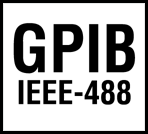Contact us
Call us at
Available 6:00 AM – 5:00 PM (PST) Business Days
Download
Download Manuals, Datasheets, Software and more:
Feedback
3 Series MDO
Mixed Domain Oscilloscopes Datasheet
More Information
- 3 Series MDO Mixed Domain Oscilloscope
- Product Support
- Explore more Software models
Read Online:
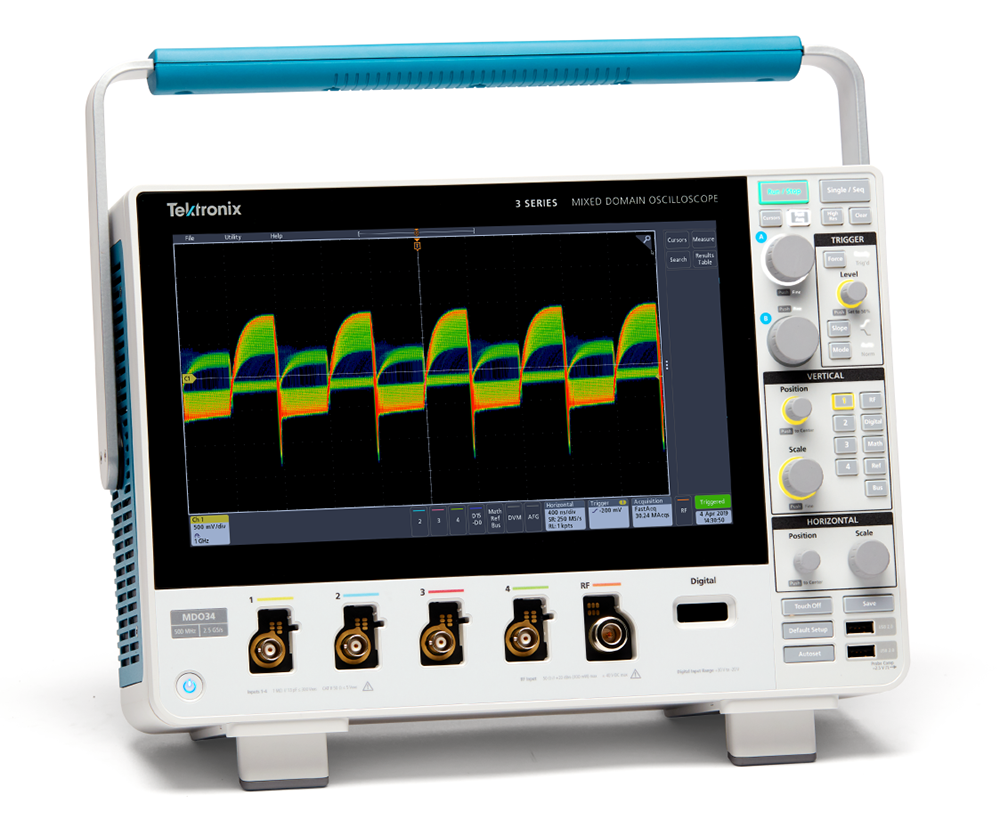
Key performance specifications
- 2 and 4 analog channel models
- 100 MHz, 200 MHz, 350 MHz, 500 MHz, 1 GHz bandwidth models
- Bandwidth is upgradable (up to 1 GHz)
- Up to 5 GS/s sample rate
- 10 M record length on all channels
- >280,000 wfm/s maximum waveform capture rate
- Standard passive voltage probes with 3.9 pF capacitive loading and 250 MHz, 500 MHz or 1 GHz analog bandwidth
- Spectrum Analyzer
- Frequency range: 9 kHz - 1 GHz (standard) or 3 GHz (optional)
- Ultra-wide capture bandwidth up to 3 GHz
- Arbitrary Function Generator (optional)
- 13 predefined waveform types
- 50 MHz waveform generation
- 128 k arbitrary generator record length
- 250 MS/s arbitrary generator sample rate
- Digital Channels (optional)
- 16 digital channels
- 10 M record length on all channels
- 121.2 ps timing resolution
- Serial Bus Decode, Triggering and Search (optional)
- Serial bus support for I2C, SPI, RS-232/422/485/UART, USB 2.0, CAN, CAN FD, LIN, FlexRay, SENT (decode only), MIL-STD-1553, ARINC429, and Audio standards
- Digital Voltmeter / Frequency Counter (Free with product registration)
- 4-digit DC, AC RMS, and DC+AC RMS voltage measurements
- 5-digit frequency measurements
Typical applications
Embedded design and IoT
Discover and solve issues quickly by performing system level debug on mixed signal embedded systems including today's most common serial bus technologies with the 3 Series MDO and support for a broad set of common serial buses.
Power design
Make reliable and repeatable voltage, current, and power measurements using automated power quality, switching loss, harmonics, ripple, modulation, and safe operating area measurements with the widest selection of power probes in an affordable solution.
Education
Managing multiple instruments on a bench can be troublesome. The 3 Series MDO combines analog, digital, and RF measurements with a signal source in a single, small (5.9 in., 149 mm deep) instrument. The combination of a small instrument and high level of integration aids in the teaching of various electronics principles as well as in its usage for more sophisticated lab experiments. Full upgradeability enables adding functionality over time as needs change or budgets allow.
Manufacturing test and troubleshooting
Size and space constraints can play havoc on a manufacturing floor. The 3 Series MDO minimizes rack or bench space by integrating multiple instruments into one small package. Integration reduces cost associated with utilizing multiple different instrument types in manufacturing test or troubleshooting stations.
Service installation and maintenance
Having the right instruments when and where you need them is critical. The 3 Series MDO combines analog waveforms, digital logic, and spectrum analysis in a lightweight (11.7 lbs, 5.3 kg), portable package - making it the perfect choice where space is limited and flexibility is desired.
Exceptionally easy-to-use user interface lets you focus on the task at hand
The Settings Bar - key parameters and waveform management
Waveform and scope operating parameters are displayed in a series of badges in the Settings Bar that runs along the bottom of the display. The Settings Bar provides immediate access for the most common waveform management tasks. With a single tap, you can:
- Turn on channels
- Add math waveforms
- Add reference waveforms
- Add bus waveforms
- Enable 16 digital channels MSO
- Enable the Spectrum Analyzer
- Enable the integrated Arbitrary/Function generator (AFG)
- Enable the integrated digital voltmeter (DVM)
The Results Bar - analysis and measurements
The Results Bar on the right side of the display includes immediate, one-tap access to the most common analytical tools such as cursors, measurements, searches and bus decode results tables.
Cursors, measurements and search results badges are displayed in the Results Bar without sacrificing any waveform viewing area. For additional waveform viewing area, the Results Bar can be dismissed and brought back at any time.
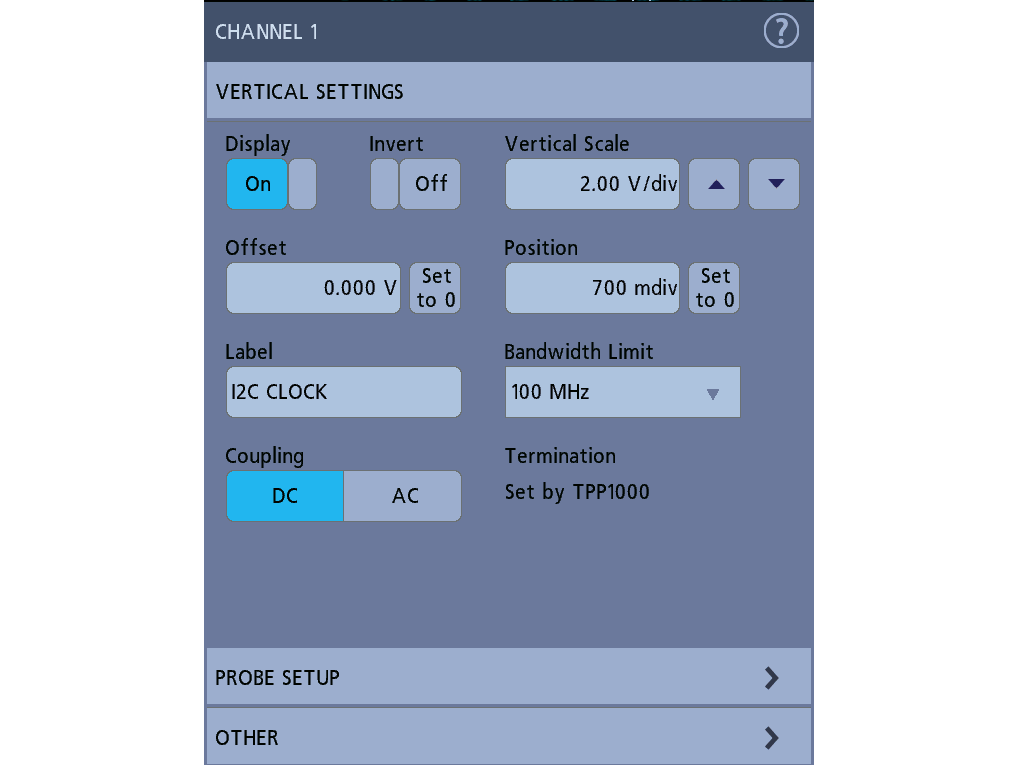
Touch interaction finally done right
Scopes have included touch screens for years, but the touch screen has been an afterthought. The 3 Series MDO 11.6" display includes a capacitive touchscreen and provides a user interface truly designed for touch.
The touch interactions that you use with phones and tablets, and expect in a touch enabled device, are supported in the 3 Series MDO.
- Drag waveforms left/right or up/down to adjust horizontal and vertical position or to pan a zoomed view
- Pinch and expand to change scale or zoom in/out in either horizontal or vertical directions
- Swipe in from the right to reveal the Results Bar or down from the top to access the menus in the upper left corner of the display
Smooth, responsive front panel controls allow you to make adjustments with familiar knobs and buttons, and you can add a mouse or keyboard as a third interaction method.
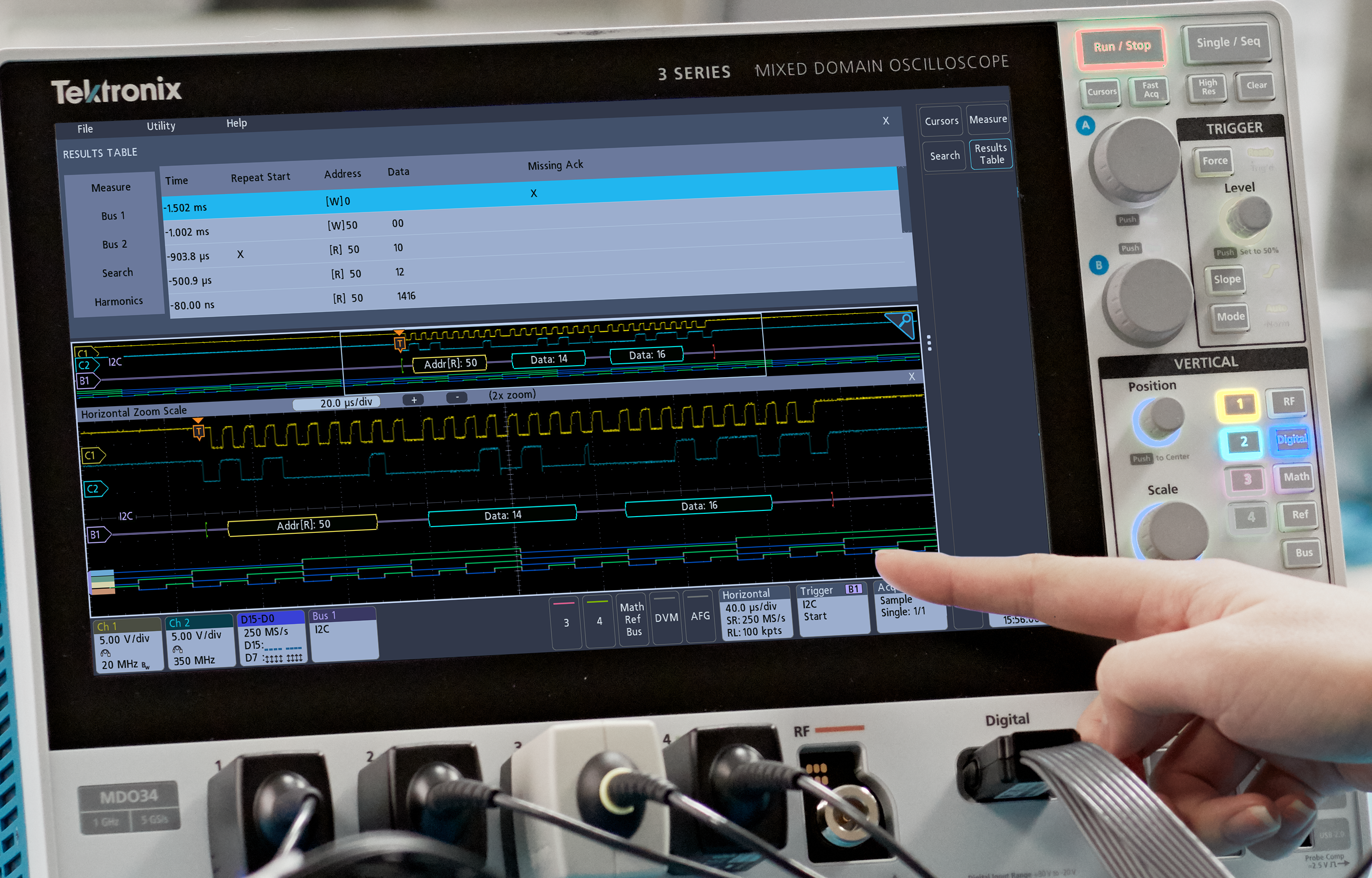
3 Series MDO front panel overview
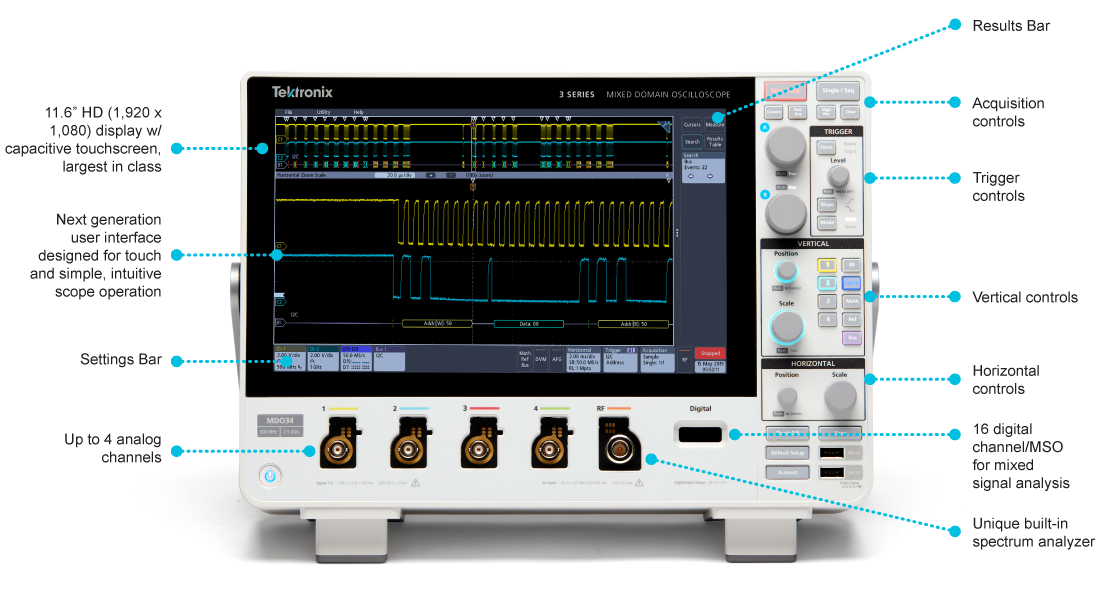
The next generation of oscilloscopes
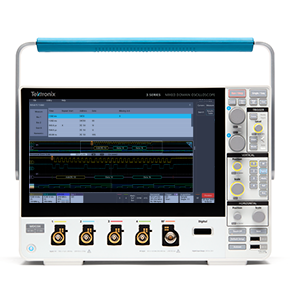 | 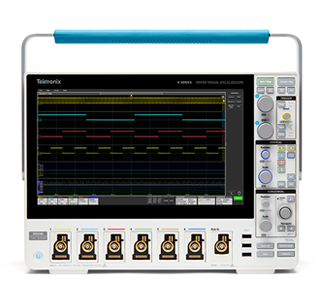 | 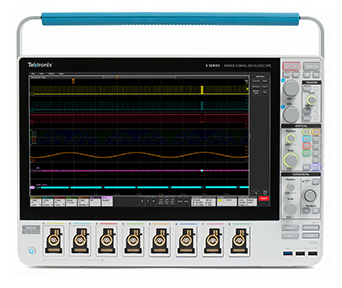 | 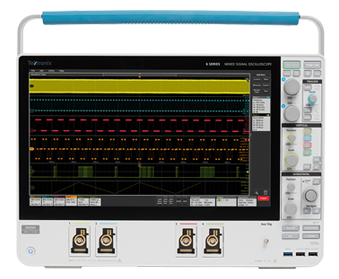 | |
| 3 Series MDO | 4 Series MSO | 5 Series MSO | 6 Series B MSO | |
| Bandwidth | up to 1 GHz | up to 1.5 GHz | up to 2 GHz | up to 10 GHz |
| Vertical Resolution | 8 bits | 12 bits | 12 bits | 12 bits |
| Display | 11.6" HD | 13.3" HD | 15.6" HD | 15.6" HD |
| Inputs | TekVPI | FlexChannel / TekVPI | FlexChannel / TekVPI | FlexChannel / TekVPI |
| Advanced Analysis | - | - | Compliance / Jitter / Windows OS | Compliance / Jitter / Windows OS |
Powerful Waveform Capture and Analysis
At the core of the 3 Series MDO is a world-class oscilloscope, offering comprehensive tools that speed each stage of debug – from quickly discovering anomalies and capturing them, to searching your waveform record for events of interest and analyzing their characteristics and your device’s behavior.
Digital phosphor technology with FastAcq™ high-speed waveform capture
To debug a design problem, first you must know it exists. Every design engineer spends time looking for problems in their design, a time- consuming and frustrating task without the right debug tools.
Digital phosphor technology provides you with fast insight into the real operation of your device. Its fast waveform capture rate – greater than 280,000 wfms/s with FastAcq – gives you a high probability of quickly seeing the infrequent problems common in digital systems: runt pulses, glitches, timing issues, and more.
To further enhance the visibility of rarely occurring events, intensity grading is used to indicate how often rare transients are occurring relative to normal signal characteristics. There are four waveform palettes available in FastAcq acquisition mode.
- The Temperature palette uses color-grading to indicate frequency of occurrence with hot colors like red/yellow indicating frequently occurring events and colder colors like blue/green indicating rarely occurring events.
- The Spectral palette uses color-grading to indicate frequency of occurrence with colder colors like blue indicating frequently occurring events and hot colors like red indicating rarely occurring events.
- The Normal palette uses the default channel color (like yellow for channel one) along with gray-scale to indicate frequency of occurrence where frequently occurring events are bright.
- The Inverted palette uses the default channel color along with gray-scale to indicate frequency of occurrence where rarely occurring events are bright.
These color palettes quickly highlight the events that over time occur more often or, in the case of infrequent anomalies, occur less often.
Infinite or variable persistence choices determine how long waveforms stay on the display, helping you to determine how often an anomaly is occurring.
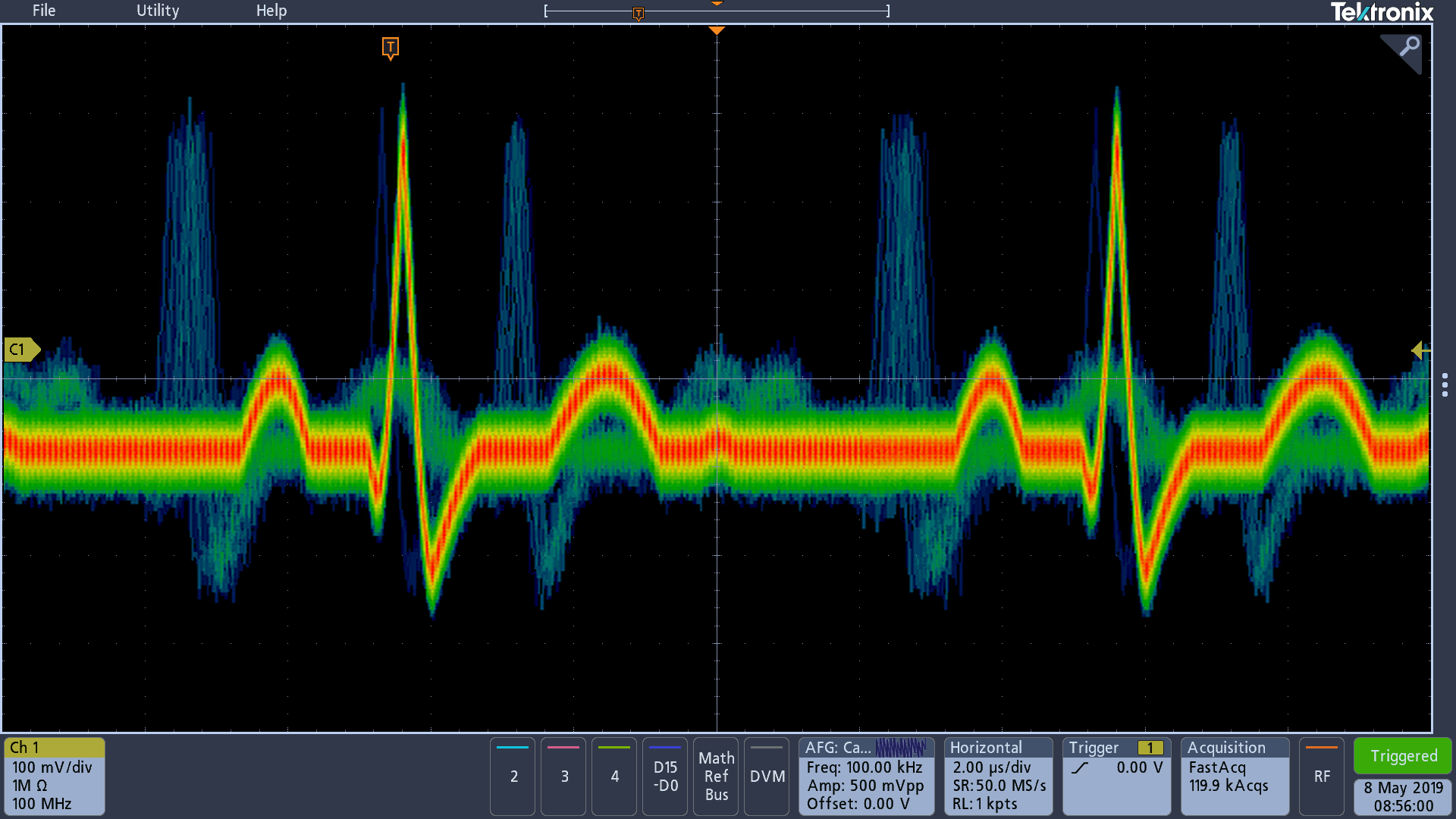
Triggering
Discovering a device fault is only the first step. Next, you must capture the event of interest to identify root cause. To enable this, the 3 Series MDO contains over 125 trigger combinations providing a complete set of triggers - including runt, logic, pulse width/glitch, setup and hold violation, serial packet, and parallel data - to help quickly locate your event of interest. And with up to a 10 M record length, you can capture many events of interest, even thousands of serial packets, in a single acquisition for further analysis while maintaining high resolution to zoom in on fine signal details.
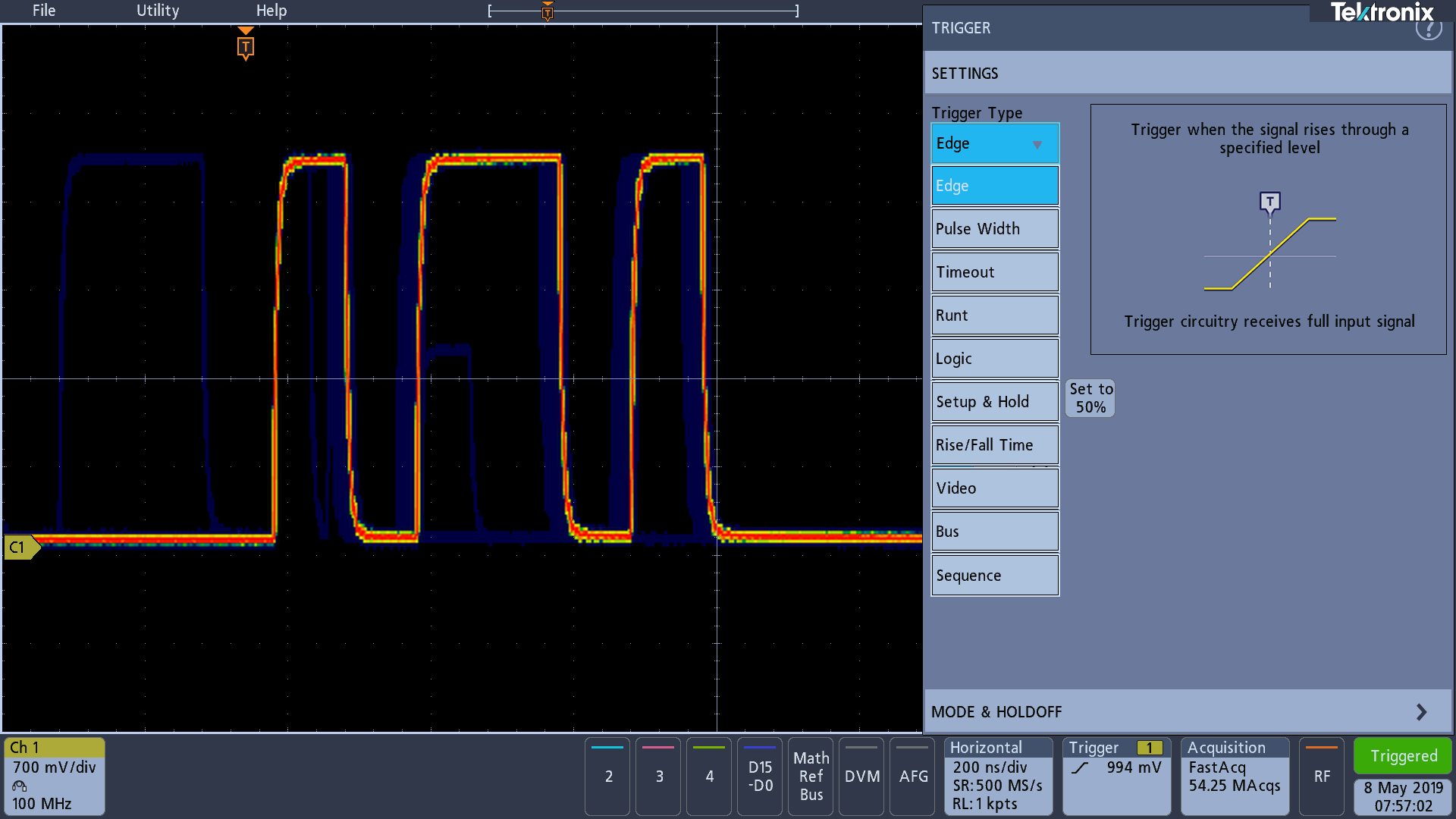
Basic waveform analysis and automated measurements
Verifying that your prototype's performance matches simulations and meets the project's design goals requires careful analysis, ranging from simple checks of rise times and pulse widths to sophisticated power loss analysis, characterization of system clocks, and investigation of noise sources.
The 3 Series MDO offers a comprehensive set of standard analysis tools including:
- Waveform- and screen-based cursors
- Up to 8 automated measurements
- Basic waveform math
- Basic FFT analysis
- Advanced waveform math with equation editor
- Mask/Limit test
Measurement results tables provide comprehensive statistical views of measurement results.
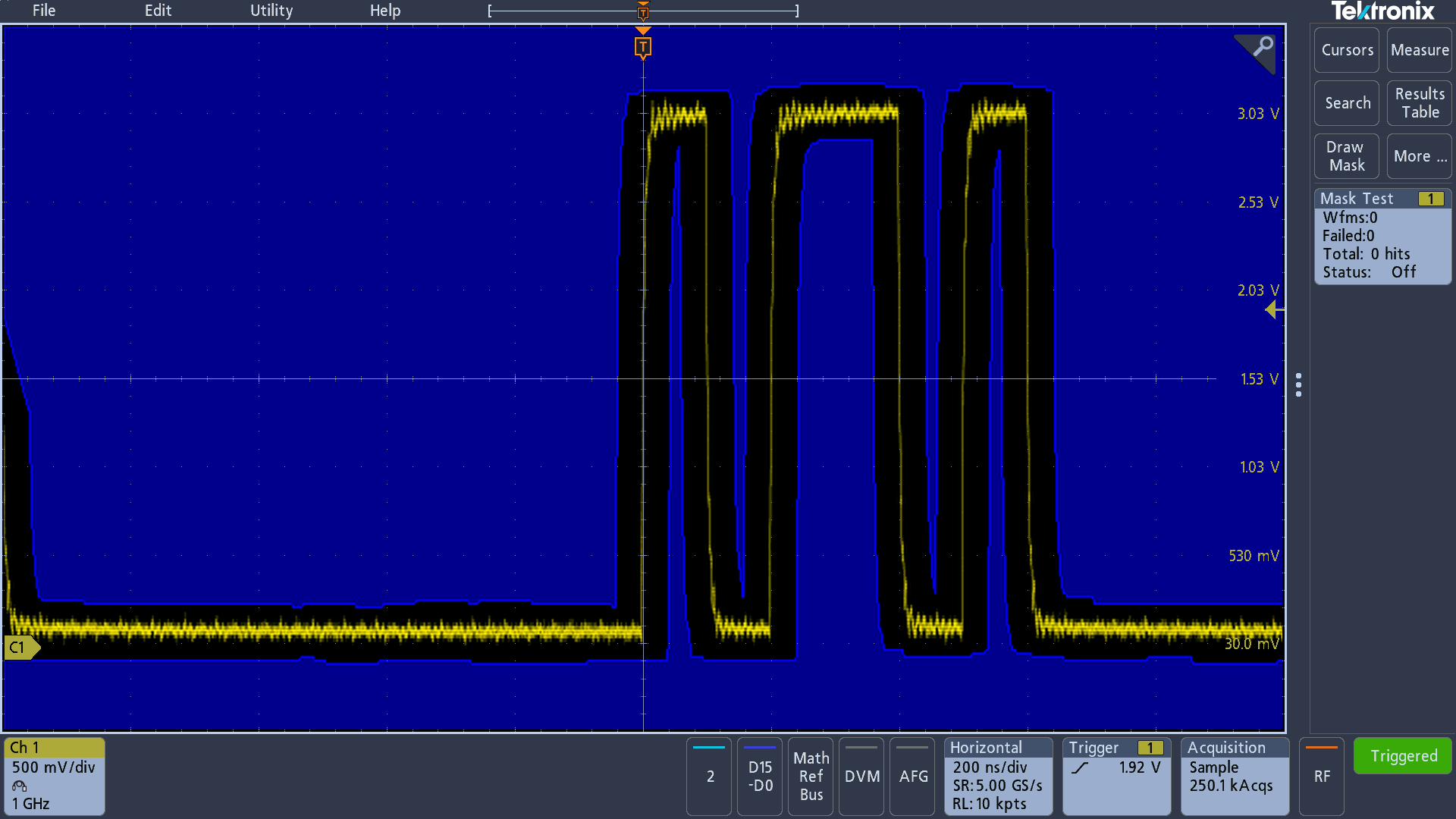
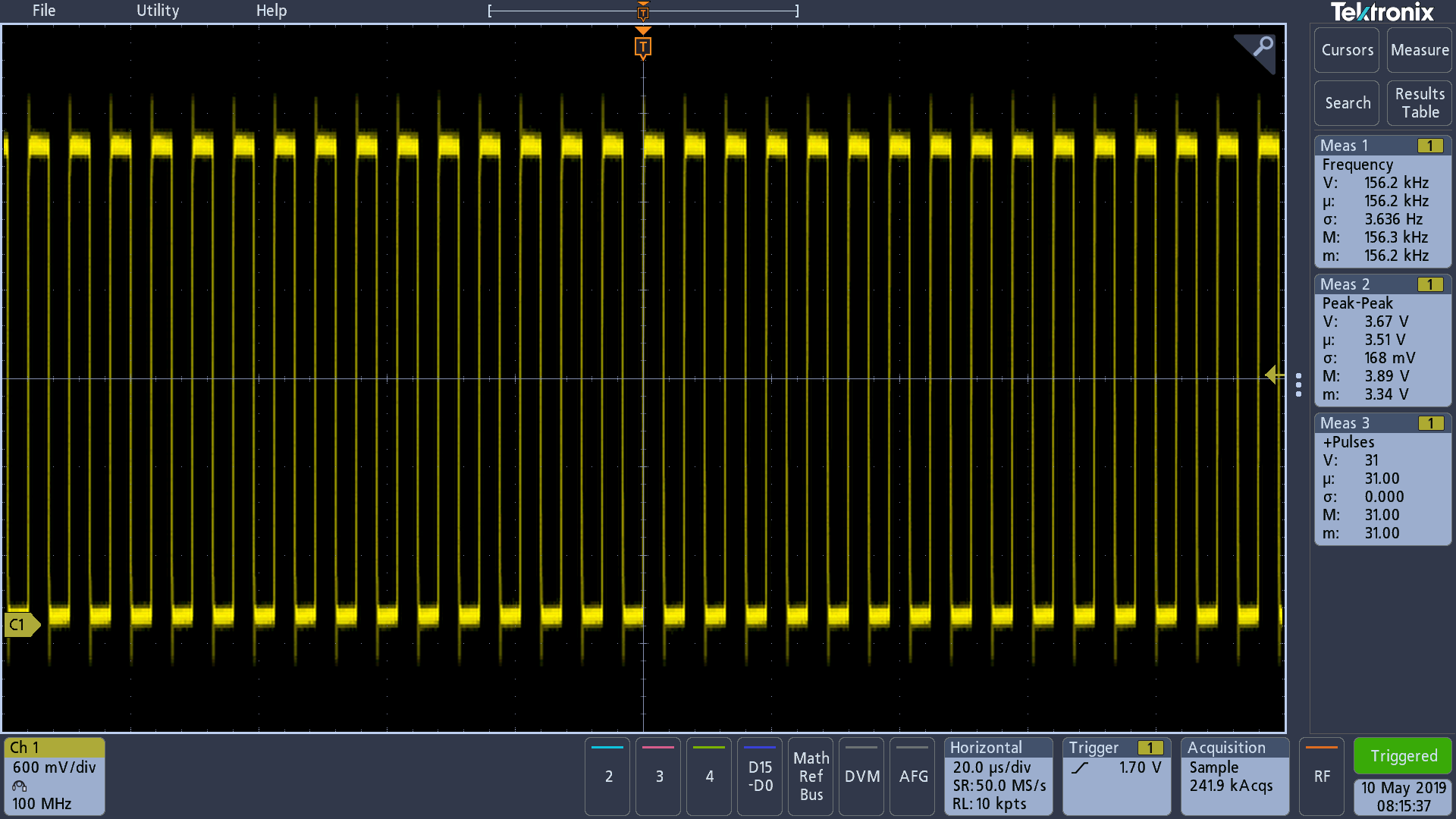
Easy navigation and search
Finding your event of interest in a long waveform record can be time consuming without the right search tools. With today's record lengths of many millions of data points, locating your event can mean scrolling through literally thousands of screens of signal activity.
The 3 Series MDO offers the industry's most comprehensive search and waveform navigation with its innovative on-screen controls. These controls speed panning and zooming through your record. Use intuitive pinch/expand gestures on the display or the multipurpose knobs to investigate areas of interest in a long record.
The Search feature allows you to automatically search through your long acquisition looking for user-defined events. All occurrences of the event are highlighted with search marks and are easily navigated to, using the Previous ( ← ) and Next ( → ) buttons found on the Search badge on the display. Search types include edge, pulse width, timeout, runt, logic, setup and hold, rise/fall time and parallel/serial bus packet content.
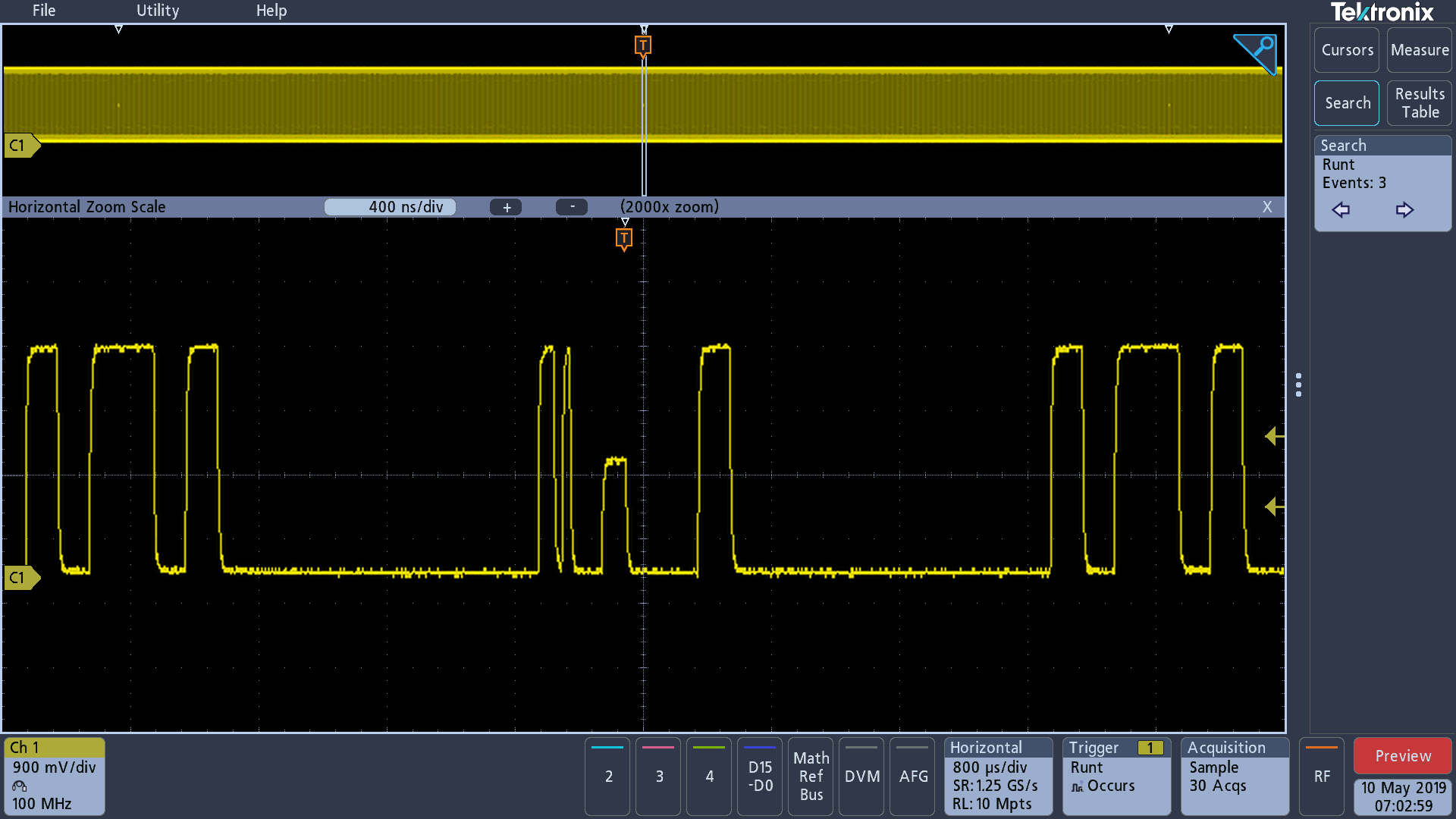
Comprehensive power analysis (optional)
Ever increasing consumer demands for longer battery-life devices and for green solutions that consume less power require power-supply designers to characterize and minimize switching losses to improve efficiency. In addition, the supply’s power levels, output purity, and harmonic feedback into the power line must be characterized to comply with national and regional power quality standards. Historically, making these and many other power measurements on an oscilloscope has been a long, manual, and tedious process. The 3 Series MDO optional power analysis tools greatly simplify these tasks, enabling quick, repeatable and accurate analysis of power quality, switching loss, harmonics, safe operating area (SOA), modulation, ripple, and slew rate (di/dt, dv/dt). Completely integrated into the oscilloscope, the power analysis tools provide automated, repeatable power measurements with a touch of a button. The optional power analysis functionality is offered free for a 30-day trial period. This free trial period starts automatically when the instrument is powered on for the first time.
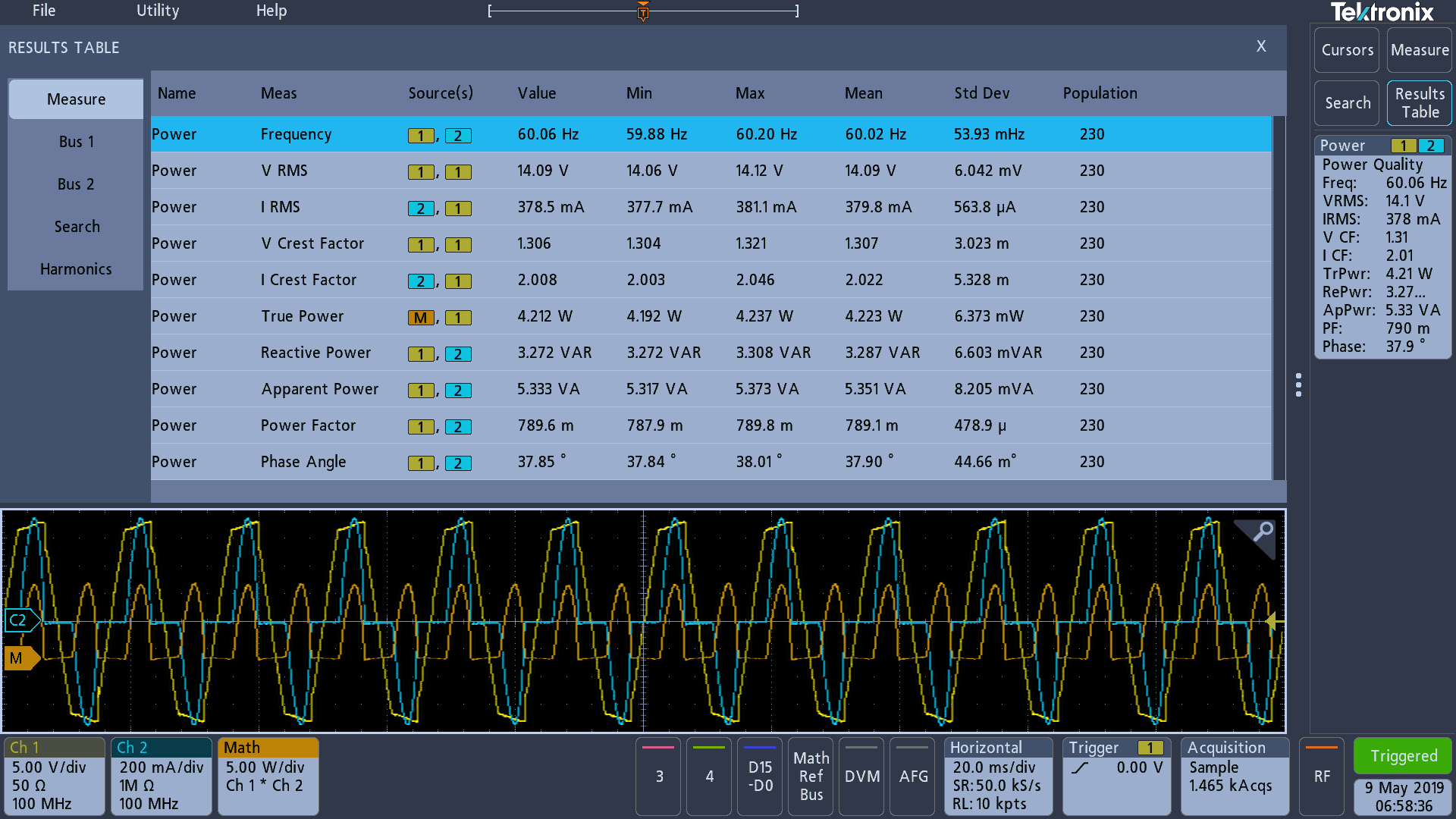
Unique built-in Spectrum Analyzer
The Tektronix MDO series is the only oscilloscope to offer an integrated, hardware-based spectrum analyzer. The spectrum analyzer frequency range of the 3 Series MDO can be from 9 kHz to 1 GHz or 3 GHz (option 3-SA3), enabling spectral analysis on IoT and most consumer wireless standards. 1 GHz comes standard on all models, 3 GHz is optional.
Fast and accurate spectral analysis
When using the spectrum analyzer standard N-connector input, the 3 Series MDO display becomes a full-screen Spectrum Analyzer view.
Key spectral parameters such as Center Frequency, Span, Reference Level, and Resolution Bandwidth are all adjusted quickly and easily using on-screen touch controls.
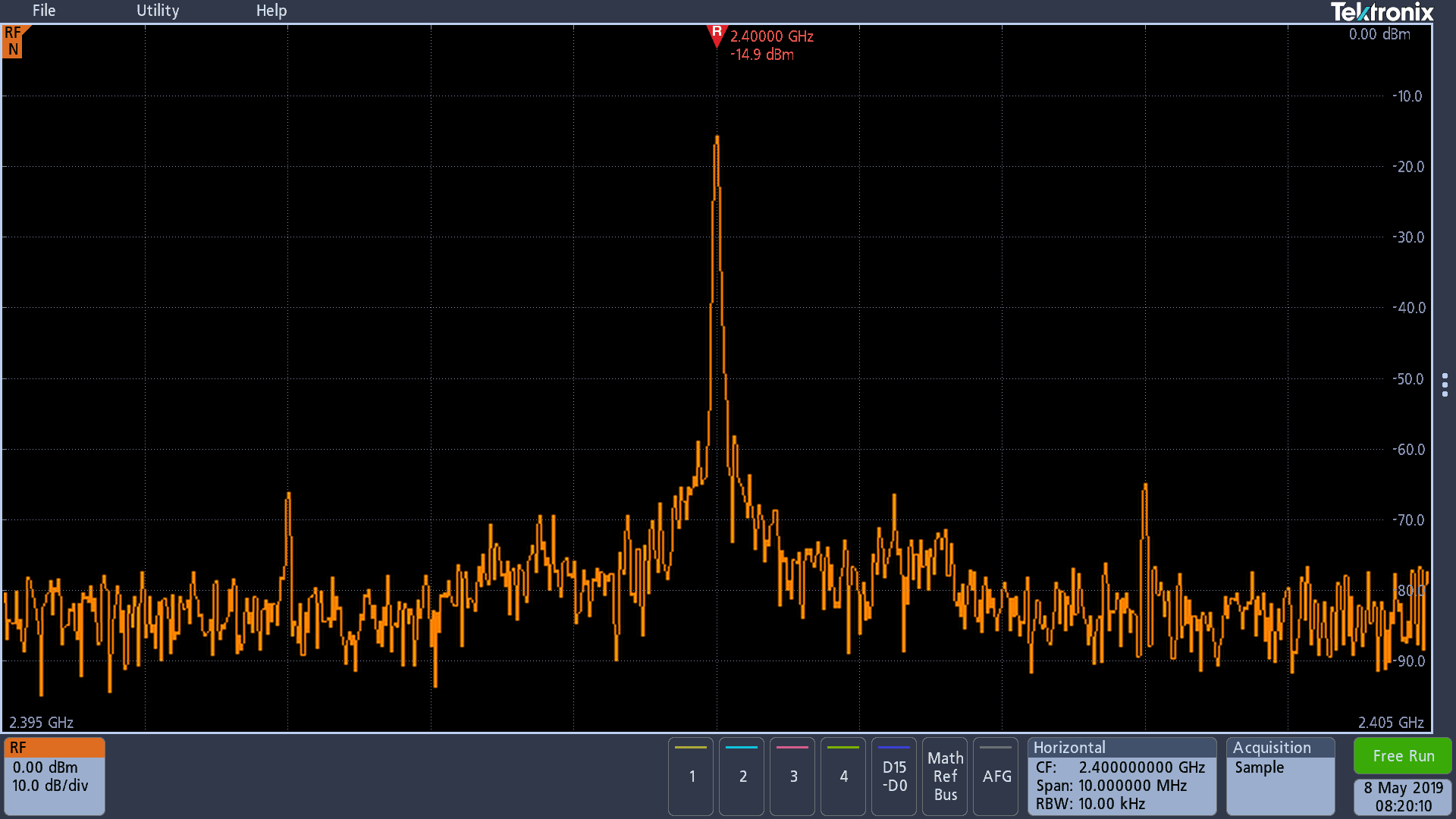
Intelligent efficient markers
In a traditional spectrum analyzer, it can be a very tedious task to turn on and place enough markers to identify all your peaks of interest. The 3 Series MDO makes this process far more efficient by automatically placing markers on peaks that indicate both the frequency and the amplitude of each peak. You can adjust the criteria that the oscilloscope uses to automatically find the peaks.
The highest amplitude peak is referred to as the reference marker and is shown in red. Marker readouts can be switched between Absolute and Delta readouts. When Delta is selected, marker readouts show each peak's delta frequency and delta amplitude from the reference marker.
Two manual cursors are also available for measuring non-peak portions of the spectrum. When enabled, the reference marker is attached to one of the cursors, enabling delta measurements from anywhere in the spectrum. In addition to frequency and amplitude, cursor readouts also include noise density and phase noise readouts depending on whether Absolute or Delta readouts are selected. A "Reference Marker to Center" function instantly moves the frequency indicated by the reference marker to center frequency.
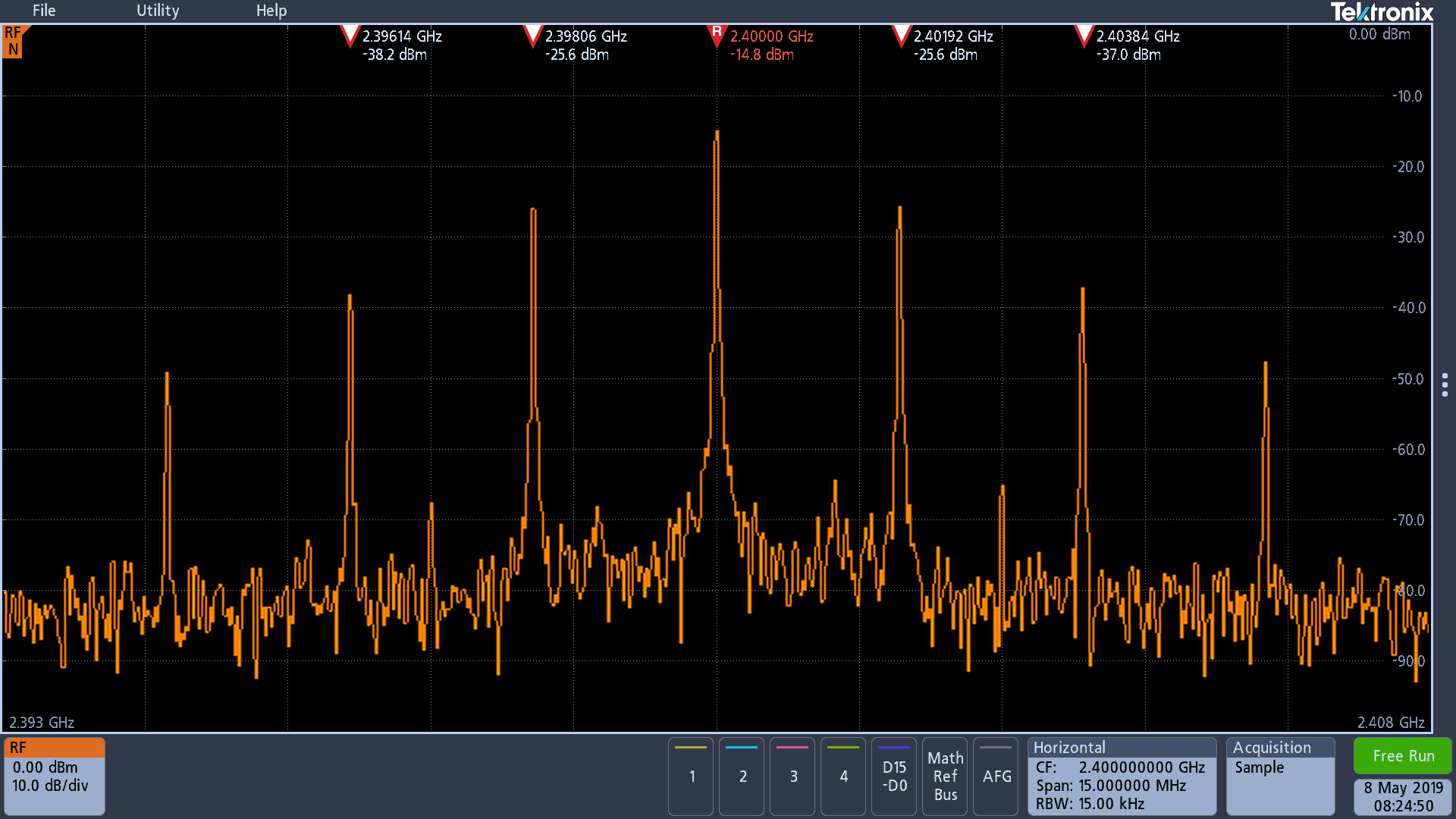
Spectrogram
The 3 Series MDO includes a spectrogram display which is ideal for monitoring slowly changing RF phenomena. The x-axis represents frequency, just like a typical spectrum display. However, the y-axis represents time, and color is used to indicate amplitude.
Spectrogram slices are generated by taking each spectrum and "flipping it up on its edge" so that it's one pixel row tall, and then assigning colors to each pixel based on the amplitude at that frequency. Cold colors (blue, green) are low amplitude and hotter colors (yellow, red) are higher amplitude. Each new acquisition adds another slice at the bottom of the spectrogram and the history moves up one row. When acquisitions are stopped, you can scroll back through the spectrogram to look at any individual spectrum slice.
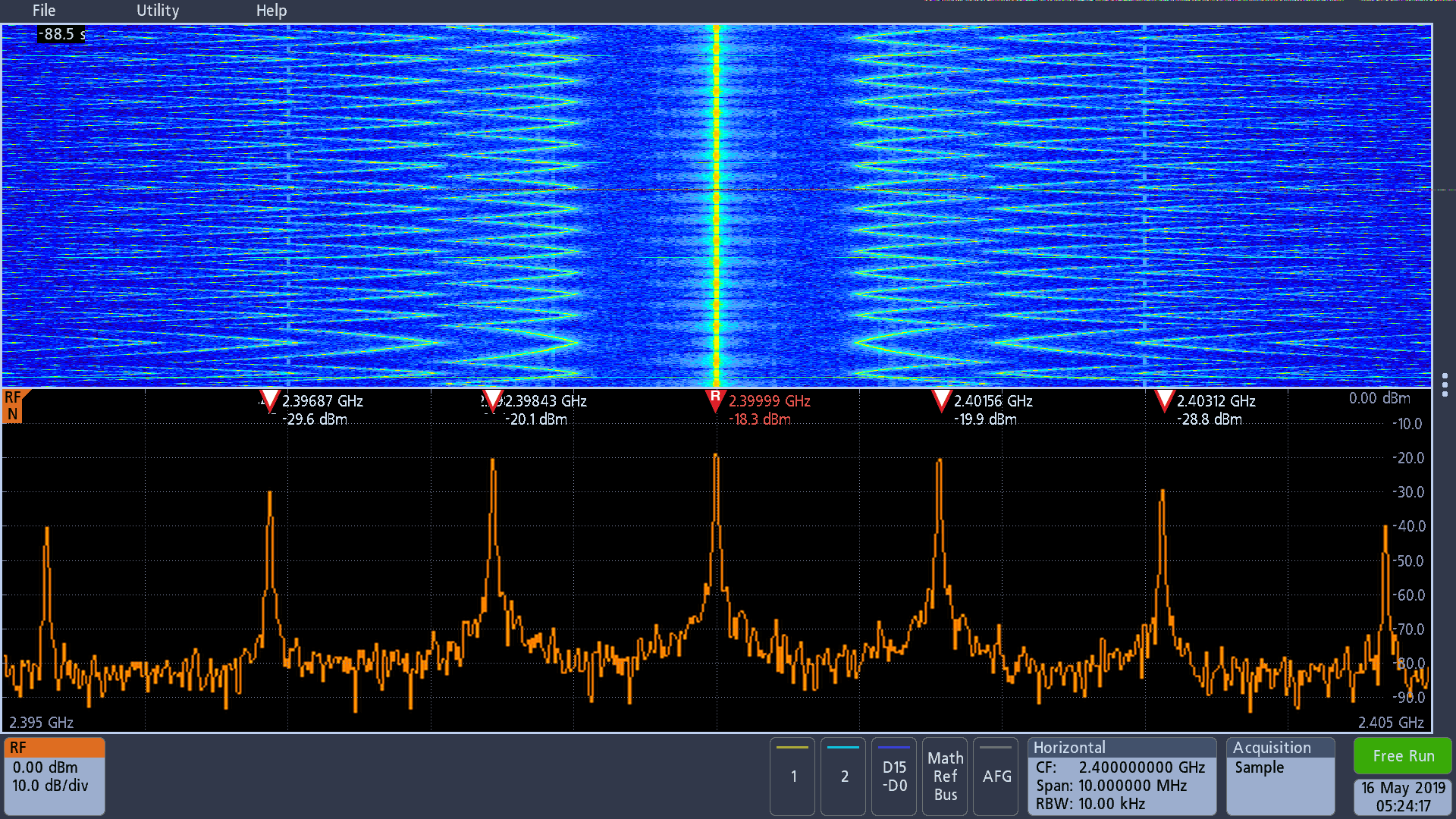
Ultra-wide capture bandwidth
Today's wireless communications vary significantly with time, using sophisticated digital modulation schemes and, often, transmission techniques that involve bursting the output. These modulation schemes can have very wide bandwidth as well. Traditional swept or stepped spectrum analyzers are ill equipped to view these types of signals as they are only able to look at a small portion of the spectrum at any one time.
The amount of spectrum acquired in one acquisition is called the capture bandwidth. Traditional spectrum analyzers sweep or step the capture bandwidth through the desired span to build the requested image. As a result, while the spectrum analyzer is acquiring one portion of the spectrum, the event you care about may be happening in another portion of the spectrum. Most spectrum analyzers on the market today have 10 MHz capture bandwidths, sometimes with expensive options to extend that to 20, 40, or even 160 MHz in some cases.
In order to address the bandwidth requirements of modern RF, the 3 Series MDO provides up to 3 GHz of capture bandwidth. The spectrum is generated from a single acquisition, thus guaranteeing you'll see the events you're looking for in the frequency domain.
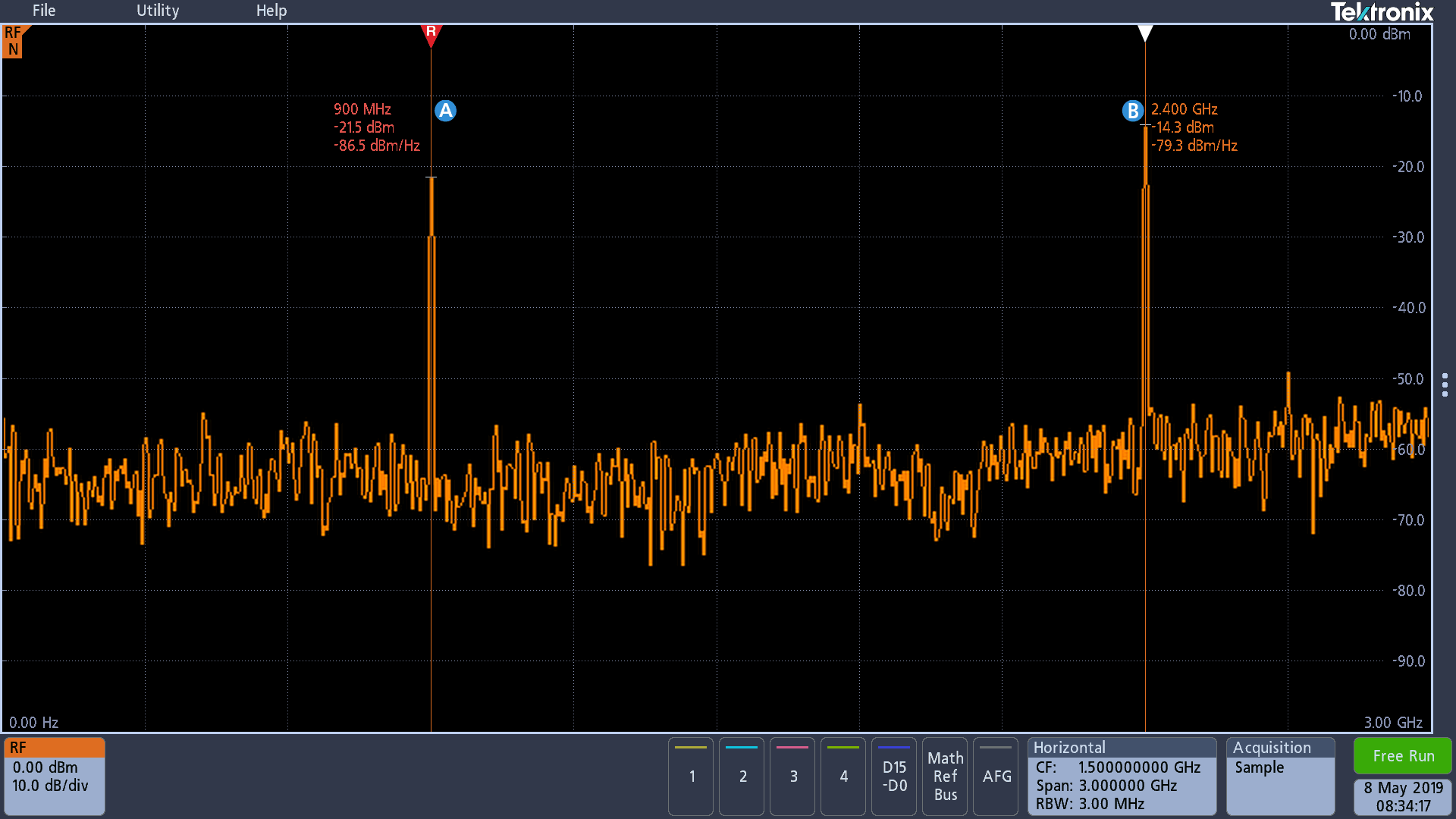
Spectrum traces
The 3 Series MDO spectrum analyzer offers four different traces or views including Normal, Average, Max Hold, and Min Hold.
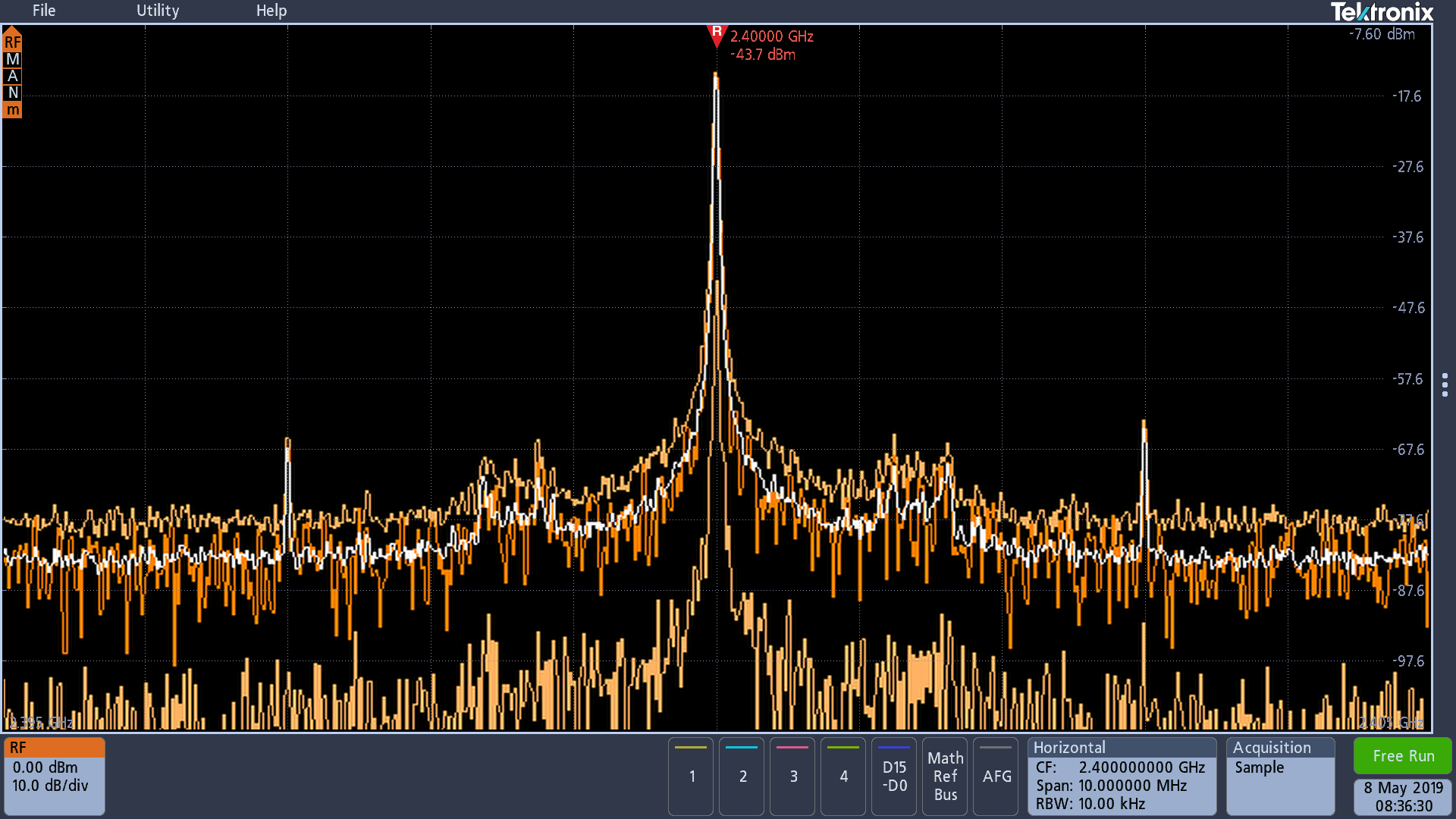
RF measurements
The 3 Series MDO includes three automated RF measurements - Channel Power, Adjacent Channel Power Ratio, and Occupied Bandwidth. When one of these RF measurements is activated, the oscilloscope automatically turns on the Average spectrum trace and sets the detection method to Average for optimal measurement results.
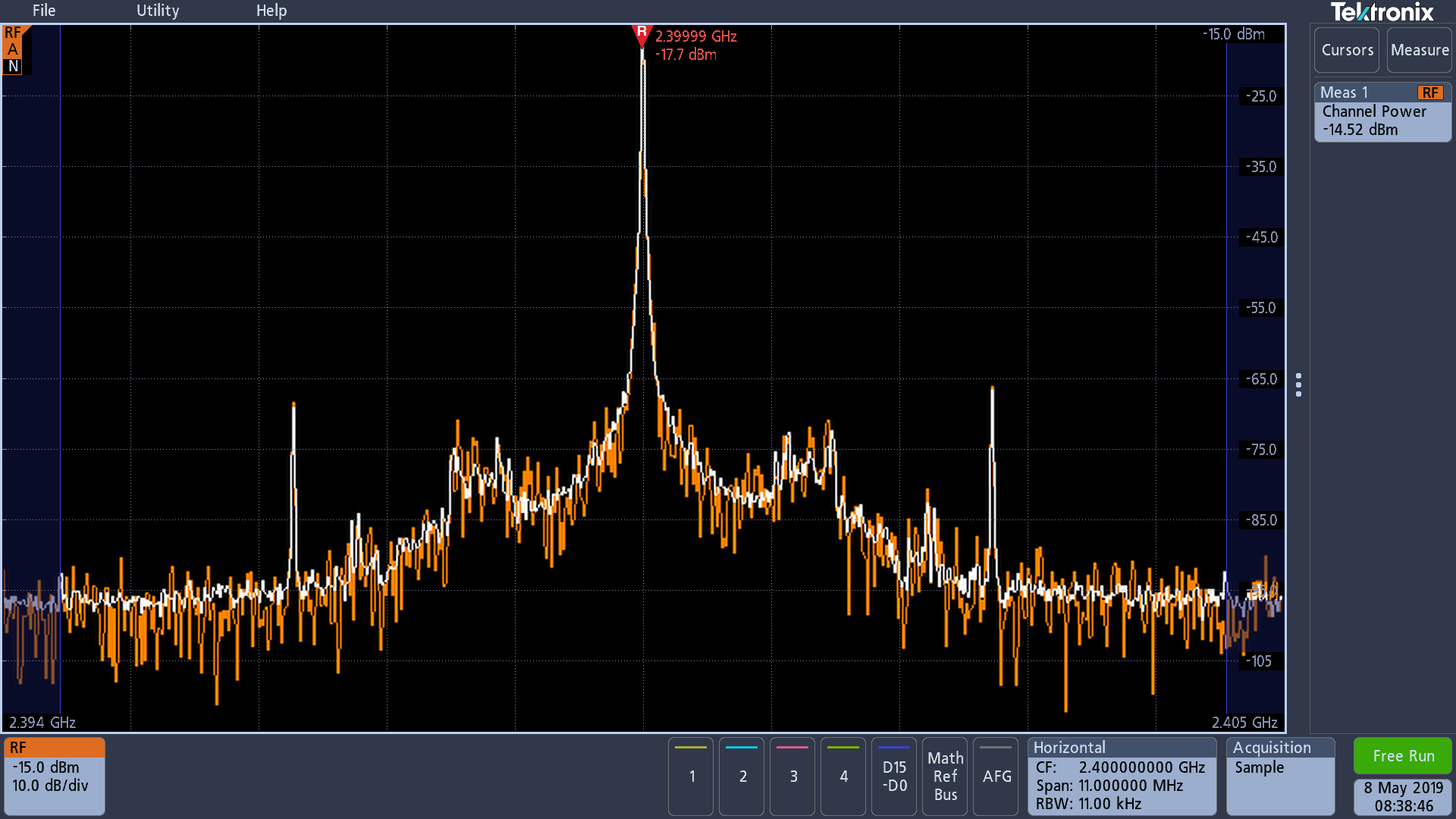
RF probing
Signal input methods on spectrum analyzers are typically limited to cabled connections or antennas. In addition to using the standard N-connector, the 3 Series MDO Spectrum Analyzer can use 50 Ω TekVPI probes with the optional TPA-N-VPI adapter. This enables additional flexibility when hunting for noise sources and enables easier spectral analysis by using true signal browsing on a spectrum analyzer input.
In addition, an optional preamplifier accessory assists in the investigation of lower-amplitude signals. The TPA-N-PRE preamplifier provides 10 dB nominal gain across the 9 kHz – 3 GHz frequency range.
Arbitrary Function Generator (optional)
The 3 Series MDO contains an optional integrated arbitrary function generator (option 3-AFG), perfect for simulating sensor signals within a design or adding noise to signals to perform margin testing.
The integrated function generator provides output of predefined waveforms up to 50 MHz for sine, square, pulse, ramp/triangle, DC, noise, sin(x)/x (Sinc), Gaussian, Lorentz, exponential rise/fall, Haversine and cardiac.
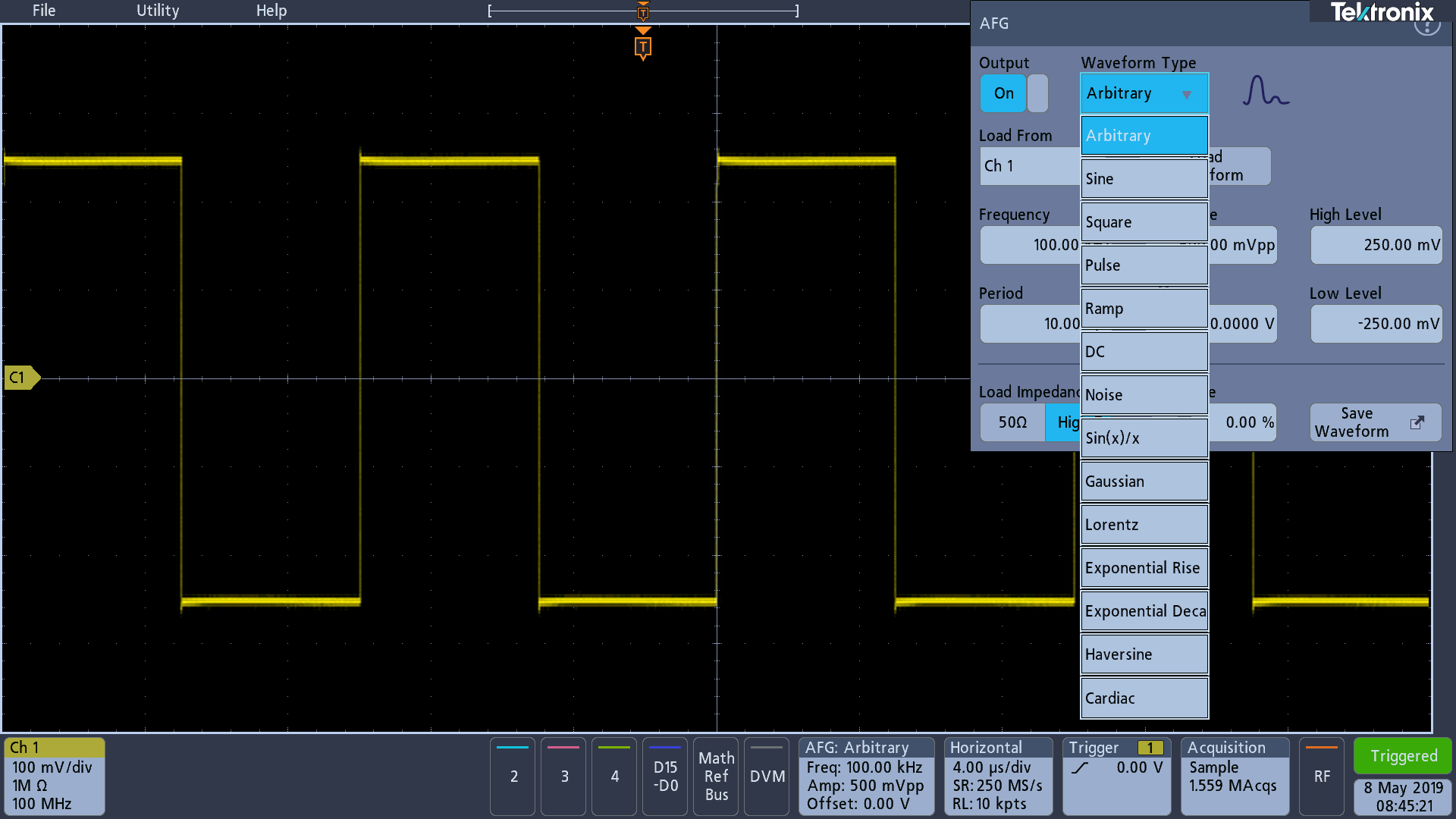
The arbitrary waveform generator provides 128 k points of record for storing waveforms from the analog input, a saved internal file location, a USB mass storage device, or from an external PC. Transfer waveform files to your 3 Series MDO edit memory via USB or LAN or using a USB mass storage device to be output from the AFG in the oscilloscope.
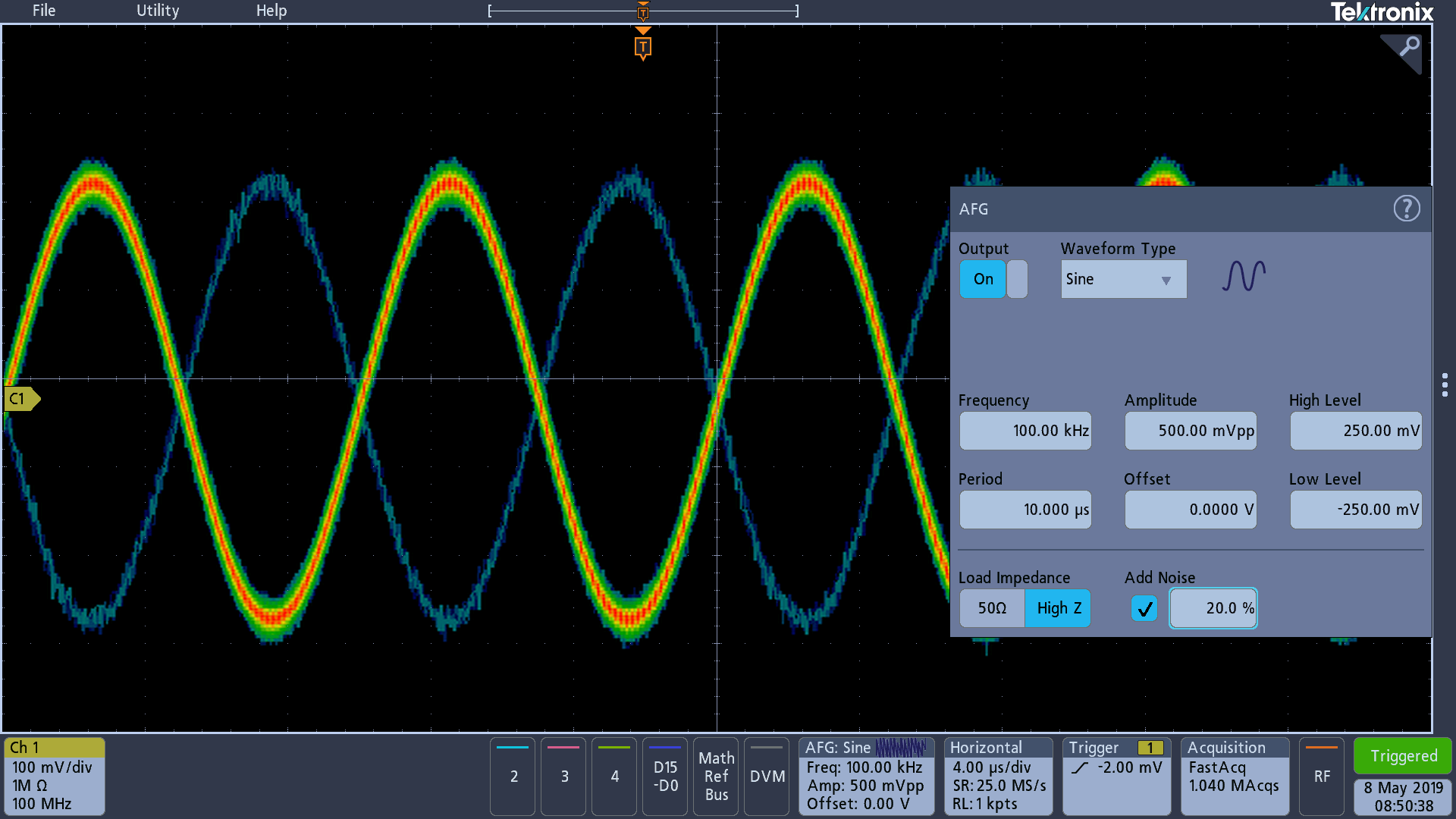
Digital Channels (optional)
The logic analyzer (option 3-MSO) provides 16 digital channels which are tightly integrated into the oscilloscope's user interface. This simplifies operation and makes it possible to solve mixed-signal issues easily.
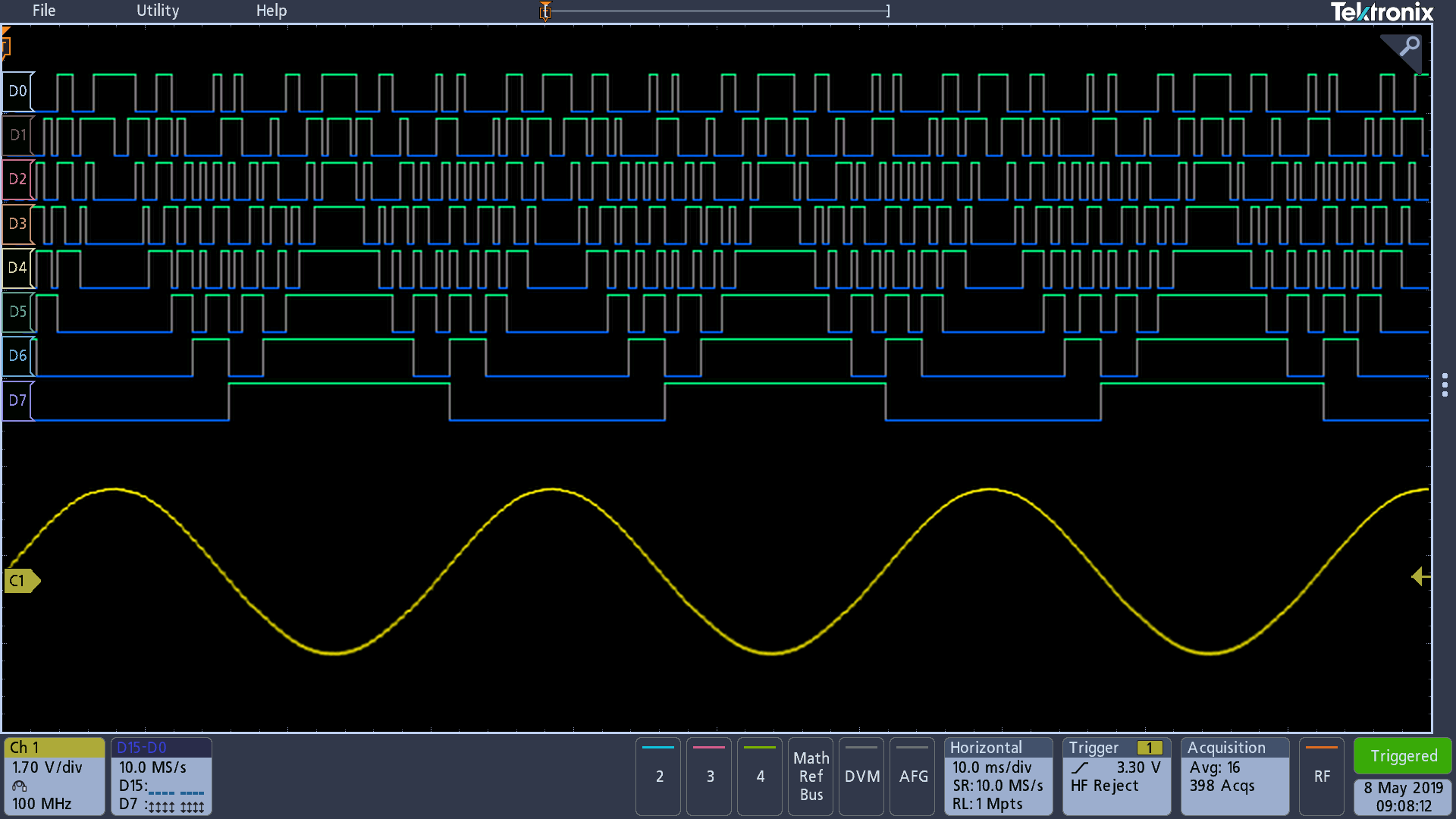
Color-coded digital waveform display
Color-coded digital traces display ones in green and zeros in blue. This coloring is also used in the digital channel monitor. The monitor shows if signals are high, low, or are transitioning so you can see channel activity at a glance without having to clutter your display with unneeded digital waveforms.
The multiple transition detection hardware shows you a white edge on the display when the system detects multiple transitions. White edges indicate that more information is available by zooming in or acquiring at faster sampling rates. In most cases zooming in will reveal the pulse that was not viewable with the previous settings. If the white edge is still present after zooming in as far as possible, this indicates that increasing the sample rate on the next acquisition will reveal higher frequency information than the previous settings could acquire.
You can group digital waveforms and enter waveform labels easily on the touchscreen. By simply placing digital waveforms next to each other, they form a group.
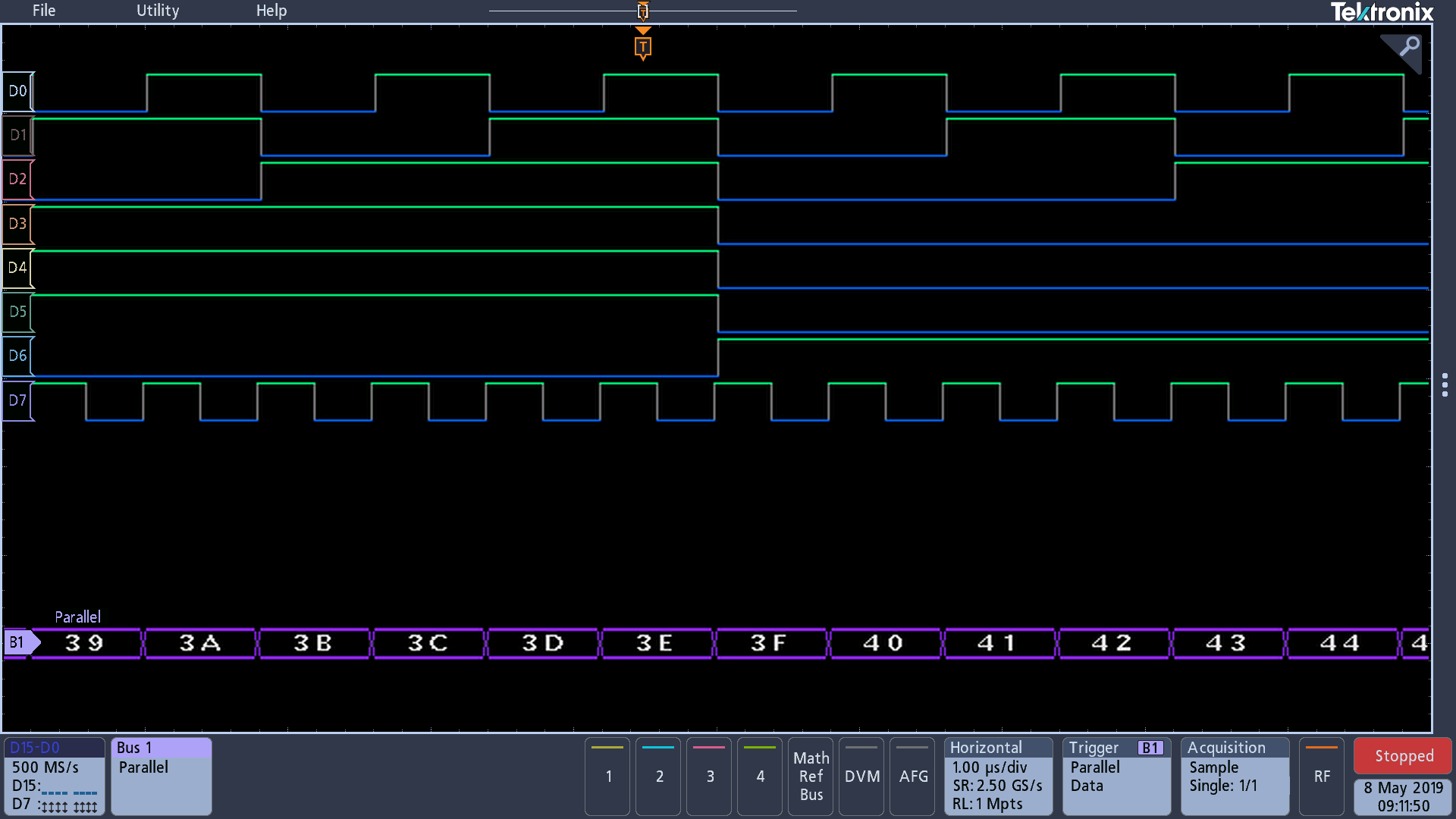
Once a group is formed, you can position all the channels contained in that group collectively. This greatly reduces the normal setup time associated with positioning channels individually
MagniVu™ high-speed acquisition
The main digital acquisition mode on the 3 Series MDO will capture up to 10 M at 500 MS/s (2 ns resolution). In addition to the main record, the 3 Series MDO provides an ultra high-resolution record called MagniVu which acquires 10,000 points at up to 8.25 GS/s (121.2 ps resolution). Both main and MagniVu waveforms are acquired on every trigger and can be switched between in the display at any time, running or stopped. MagniVu provides significantly finer timing resolution than comparable oscilloscopes on the market, instilling confidence when making critical timing measurements on digital waveforms.
P6316 MSO probe
This unique probe design offers two eight-channel pods, simplifying the process of connecting to the device-under-test. When connecting to square pins, the P6316 can connect directly to 8×2 square pin headers spaced on tenth-inch centers. When more attachment flexibility is required, you can use the included flying lead sets and grabbers to clip onto surface mount devices or test points. The P6316 offers outstanding electrical characteristics applying only 8 pF of capacitive loading with 101 kΩ input impedance.
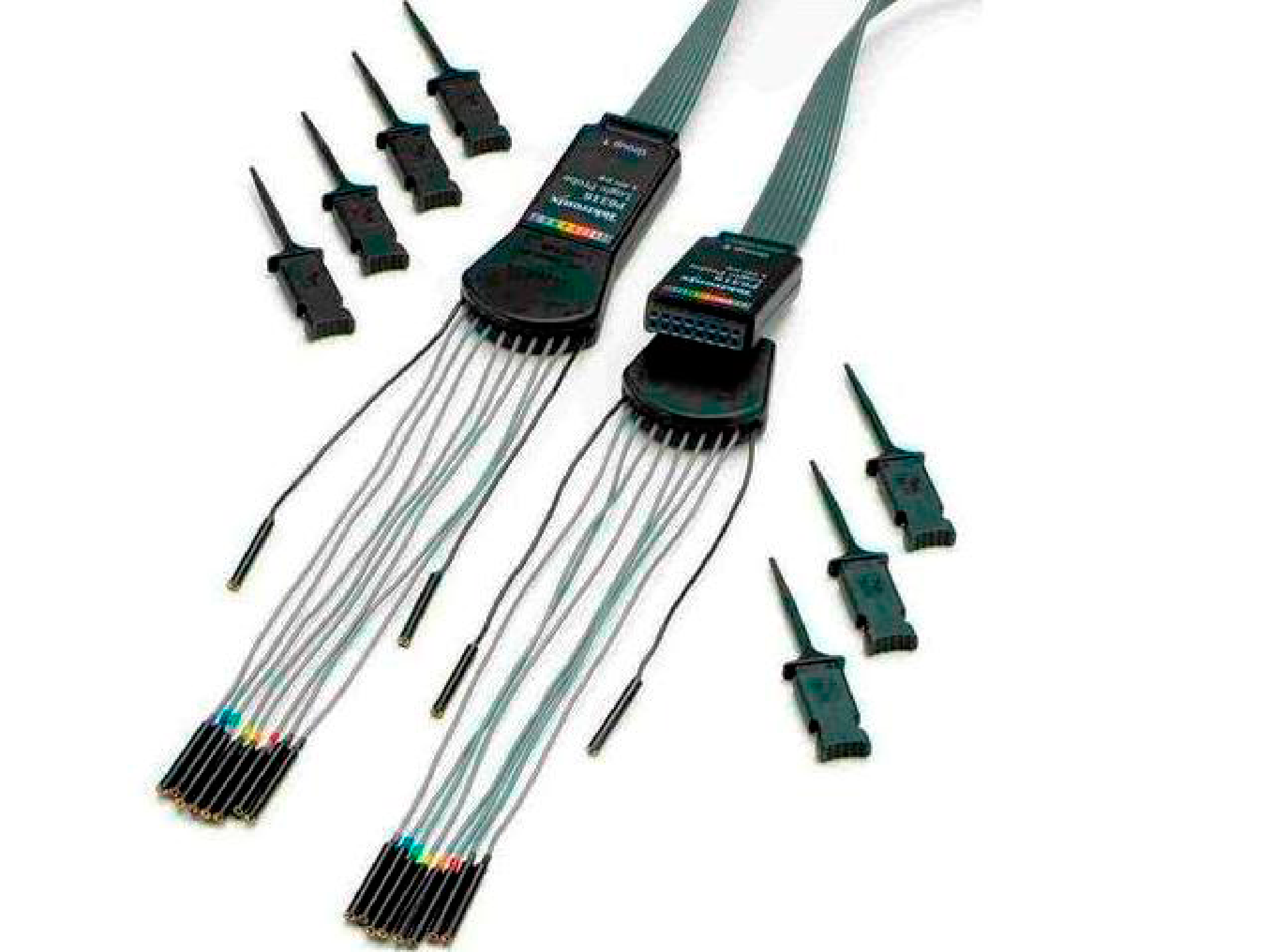
Serial Protocol Triggering and Analysis (optional)
On a serial bus, a single signal often includes address, control, data, and clock information. This can make isolating events of interest difficult. Automatic trigger, decode, and search on bus events and conditions gives you a robust set of tools for debugging serial buses. The optional serial protocol triggering and analysis functionality is offered free for a 30-day trial period. This free trial period starts automatically when the instrument is powered on for the first time.
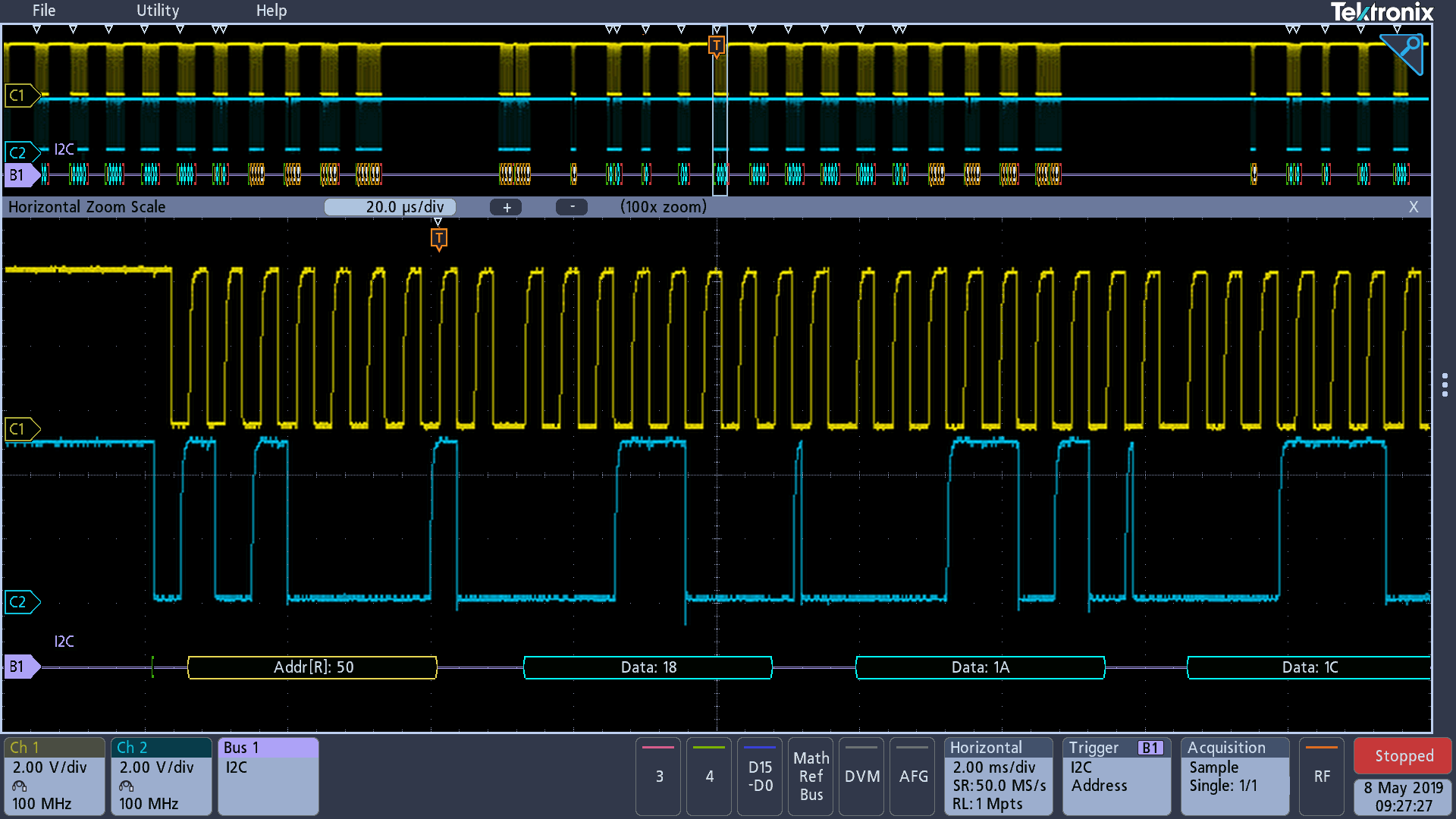
Serial triggering
Trigger on packet content such as start of packet, specific addresses, specific data content, unique identifiers, etc. on popular serial interfaces such as I2C, SPI, RS-232/422/485/UART, USB2.0, CAN, CAN FD, LIN, FlexRay, MIL-STD-1553, ARINC429, and I2S/LJ/RJ/TDM.
Bus display
Provides a higher-level, combined view of the individual signals (clock, data, chip enable, etc.) that make up your bus, making it easy to identify where packets begin and end and identifying sub-packet components such as address, data, identifier, CRC, etc.
Bus decoding
Tired of having to visually inspect the waveform to count clocks, determine if each bit is a 1 or a 0, combine bits into bytes, and determine the hex value? Let the oscilloscope do it for you. Once you’ve set up a bus, the 3 Series MDO will decode each packet on the bus, and display the value in hex, binary, decimal (SENT, USB, CAN, CAN FD, LIN, FlexRay, MIL-STD-1553, and ARINC429 only), signed decimal (I2S/LJ/RJ/TDM only), or ASCII (USB, MIL-STD-1553 and RS-232/422/485/UART only) in the bus waveform.
| Technology | Trigger, Decode, Search | Order product | |
|---|---|---|---|
| Embedded | I2C | Yes | 3-SREMBD |
| SPI | Yes | 3-SREMBD | |
| Computer | RS232/422/485, UART | Yes | 3-SRCOMP |
| USB | USB LS, FS, HS | Yes (trigger on LS and FS only; HS decode only on 1 GHz models) | 3-SRUSB2 |
| Automotive | CAN, CAN FD | Yes | 3-SRAUTO |
| LIN | Yes | 3-SRAUTO | |
| FlexRay | Yes | 3-SRAUTO | |
| SENT | Decode only | 3-SRAUTOSEN | |
| Military and Aerospace | MIL-STD-1553, ARINC429 | Yes | 3-SRAERO |
| Audio | I2S | Yes | 3-SRAUDIO |
| LJ, RJ | Yes | 3-SRAUDIO | |
| TDM | Yes | 3-SRAUDIO | |
Event table
In addition to seeing decoded packet data on the bus waveform itself, you can view all captured packets in a tabular view much like you would see in a software listing. Packets are time stamped and listed consecutively with columns for each component (Address, Data, etc.). You can save the event table data in .CSV format.
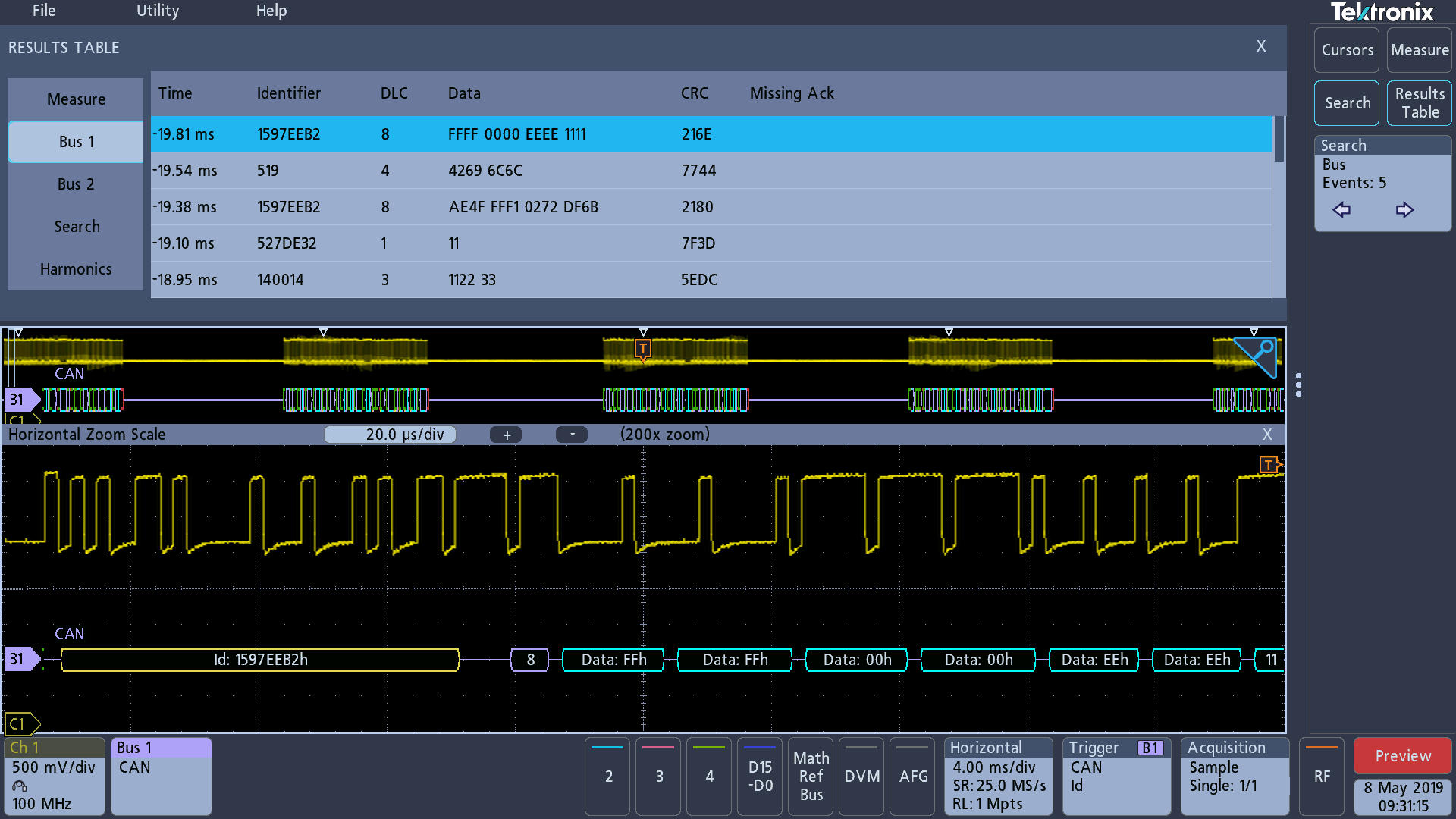
Search (serial triggering)
Serial triggering is very useful for isolating the event of interest, but once you’ve captured it and need to analyze the surrounding data, what do you do? In the past, users had to manually scroll through the waveform counting and converting bits and looking for what caused the event. You can have the oscilloscope automatically search through the acquired data for user-defined criteria including serial packet content. Each occurrence is highlighted by a search mark. Rapid navigation between marks is as simple as pressing the Previous (←) and Next (→) buttons on the screen.
Digital Voltmeter (DVM) and Frequency Counter (free with registration)
The 3 Series MDO contains an integrated 4-digit digital voltmeter (DVM) and 5-digit frequency counter. Any of the analog inputs can be a source for the voltmeter, using the same probes that are already attached for general oscilloscope usage. The DVM and frequency counter is available on any 3 Series MDO and is activated when you register your product.
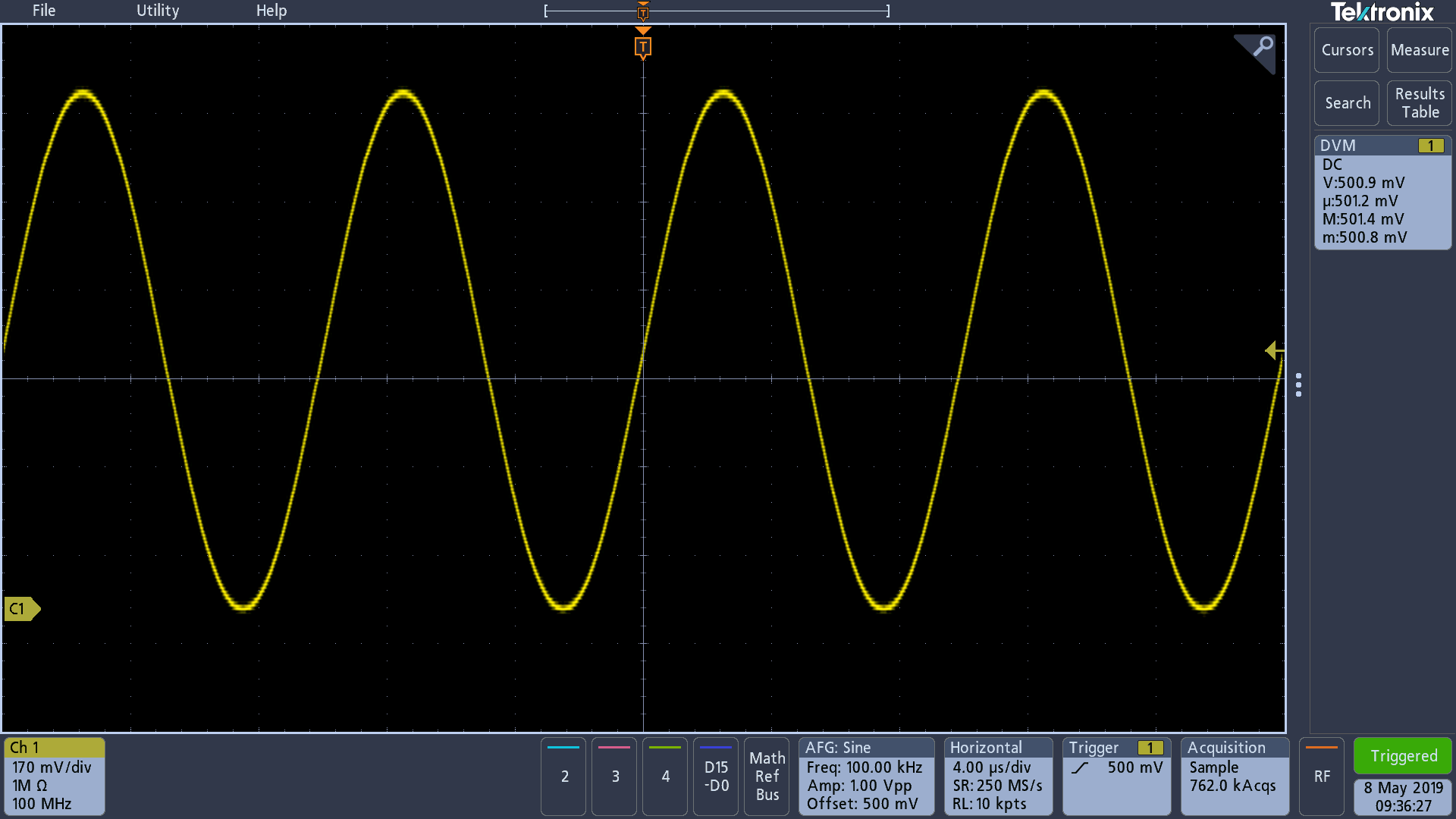
The 3 Series MDO Platform
Large high-resolution touch display
The 3 Series MDO features an 11.6 inch (295 mm) wide-screen, HD display (1920 x 1080) for seeing intricate signal details.
Connectivity
The 3 Series MDO contains a number of ports which can be used to connect the instrument to a network, directly to a PC, or other test equipment.
- Front and rear USB host ports enable easy transfer of screen shots, instrument settings, and waveform data to a USB mass storage device. A USB keyboard or mouse can also be attached to a USB host port for data entry or control.
- Rear USB device port is useful for controlling the oscilloscope remotely from a PC.
- The standard 10/100 Ethernet port on the rear of the instrument enables easy connection to networks, provides network printing, and provides LXI Core 2011 compatibility.
- A HDMI port on the rear of the instrument allows the display to be exported to an external monitor or projector.
Remote connectivity and instrument control
Exporting data and measurements is as simple as connecting a USB cable from the oscilloscope to your PC. Key software applications – OpenChoice® Desktop, and Microsoft Excel and Word toolbars enable fast and easy direct communication with your Windows PC.
The OpenChoice Desktop enables fast and easy communication between the oscilloscope and your PC through USB or LAN for transferring settings, waveforms, and screen images.
The embedded e*Scope® capability enables fast control of the oscilloscope over a network connection through a standard web browser. Simply enter the IP address or network name of the oscilloscope and a web page will be served to the browser. Transfer and save settings, waveforms, measurements, and screen images or make live control changes to settings on the oscilloscope directly from the web browser.
Compact form factor
With the compact, portable form factor, you can easily move the oscilloscope between labs. And with a depth of just 5.9 inches (149 mm), it saves you valuable space on your test bench. The 3 Series MDO has all the tools you'll need for everyday debug tasks, all in a single instrument.
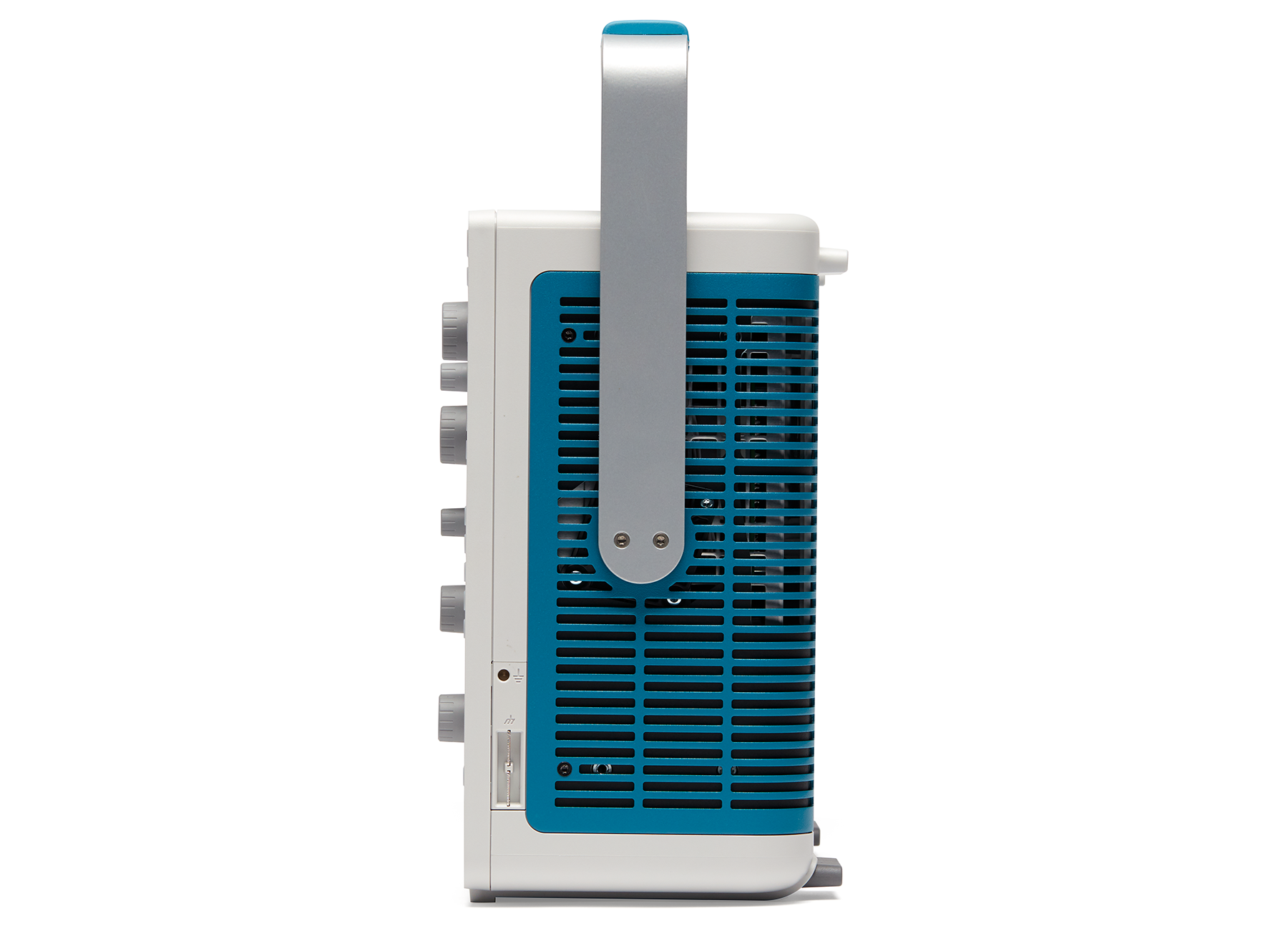
Accurate high-speed probing
The 3 Series MDO ships standard with passive voltage probes and uses the TekVPI probe interface.
Standard passive voltage probes
The 3 Series MDO include passive voltage probes with industry best capacitive loading of only 3.9 pF. The included TPP probes minimize the impact on devices under test and accurately deliver signals to the oscilloscope for acquisition and analysis. The following table shows which TPP probes come standard with each 3 Series MDO model.
| 3 Series models: MDO32, MDO34 | Included probe |
|---|---|
| 100 MHz, 200 MHz | TPP0250: 250 MHz, 10x passive voltage probe. One per analog channel. |
| 350 MHz, 500 MHz | TPP0500B: 500 MHz, 10x passive voltage probe. One per analog channel. |
| 1 GHz | TPP1000: 1 GHz, 10x passive voltage probe. One per analog channel. |
TekVPI probe interface
The TekVPI probe interface sets the standard for ease of use in probing. In addition to the secure, reliable connection that the interface provides, TekVPI probes feature status indicators and controls, as well as a probe menu button right on the comp box itself. This button brings up a probe menu on the oscilloscope display with all relevant settings and controls for the probe. The TekVPI interface enables direct attachment of current probes without requiring a separate power supply. TekVPI probes can be controlled remotely through USB, GPIB, or LAN, enabling more versatile solutions in ATE environments. The instrument provides up to 25 W of power to the front panel connectors from the internal power supply.
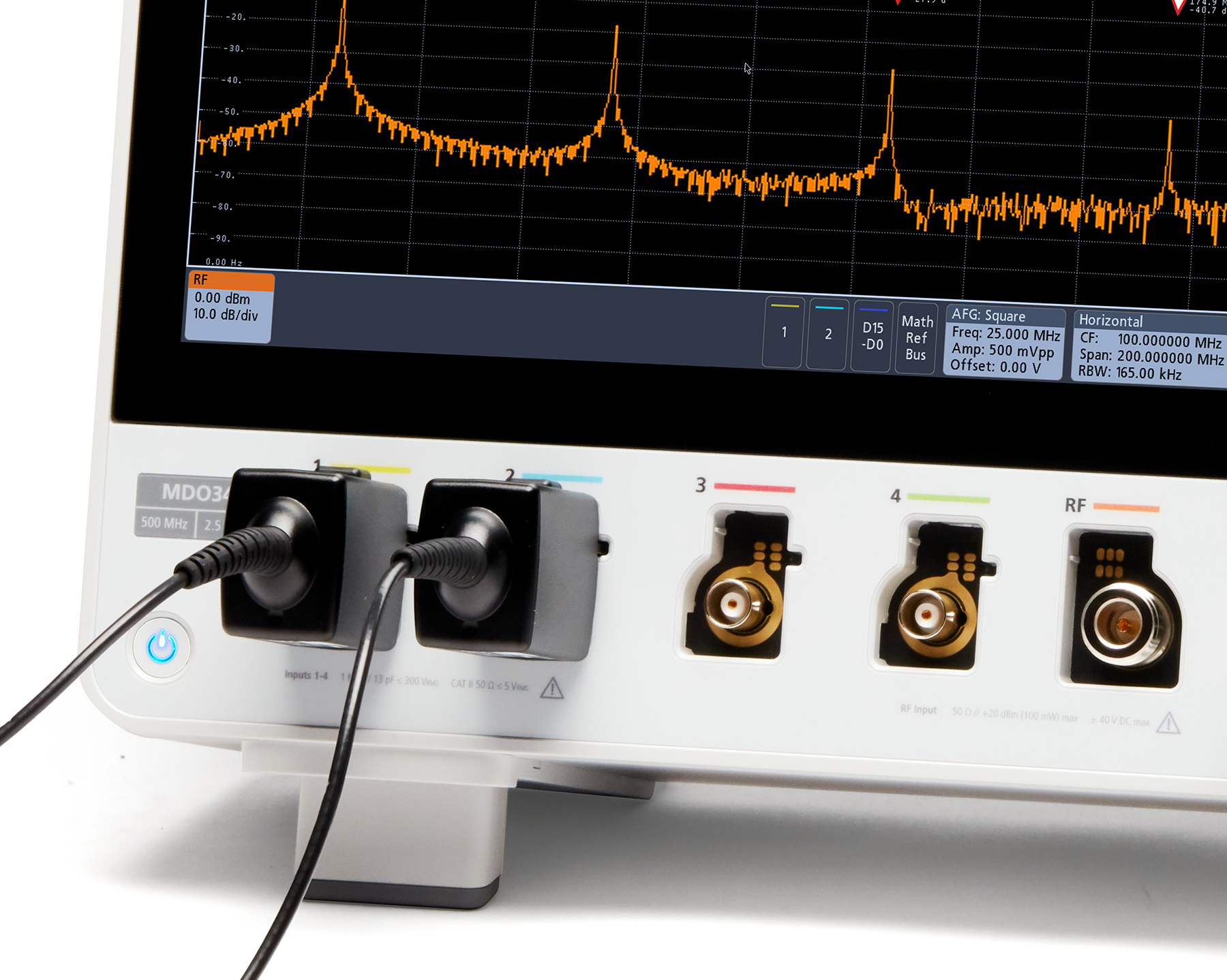
Specifications
All specifications are guaranteed unless noted otherwise. All specifications apply to all models unless noted otherwise.
Model overview
| MDO32 and MDO34 | ||||||||||
|---|---|---|---|---|---|---|---|---|---|---|
| Analog channel bandwidth | 100 MHz | 100 MHz | 200 MHz | 200 MHz | 350 MHz | 350 MHz | 500 MHz | 500 MHz | 1 GHz | 1 GHz |
| Analog channels | 2 | 4 | 2 | 4 | 2 | 4 | 2 | 4 | 2 | 4 |
Rise time (typical, calculated) (10 mV/div setting with 50 Ω input termination) | 3.5 ns | 3.5 ns | 2 ns | 2 ns | 1.14 ns | 1.14 ns | 800 ps | 800 ps | 400 ps | 400 ps |
| Sample rate (1 ch) | 2.5 GS/s | 2.5 GS/s | 2.5 GS/s | 2.5 GS/s | 2.5 GS/s | 2.5 GS/s | 2.5 GS/s | 2.5 GS/s | 5 GS/s | 5 GS/s |
| Sample rate (2 ch) | 2.5 GS/s | 2.5 GS/s | 2.5 GS/s | 2.5 GS/s | 2.5 GS/s | 2.5 GS/s | 2.5 GS/s | 2.5 GS/s | 5 GS/s | 5 GS/s |
| Sample rate (4 ch) | - | 2.5 GS/s | - | 2.5 GS/s | - | 2.5 GS/s | - | 2.5 GS/s | - | 2.5 GS/s |
| Record length (1 ch) | 10 M | 10 M | 10 M | 10 M | 10 M | 10 M | 10 M | 10 M | 10 M | 10 M |
| Record length (2 ch) | 10 M | 10 M | 10 M | 10 M | 10 M | 10 M | 10 M | 10 M | 10 M | 10 M |
| Record length (4 ch) | - | 10 M | - | 10 M | - | 10 M | - | 10 M | - | 10 M |
| Digital channels with 3-MSO option | 16 | 16 | 16 | 16 | 16 | 16 | 16 | 16 | 16 | 16 |
| Arbitrary Function Generator outputs with 3-AFG option | 1 | 1 | 1 | 1 | 1 | 1 | 1 | 1 | 1 | 1 |
| Spectrum analyzer channels | 1 | 1 | 1 | 1 | 1 | 1 | 1 | 1 | 1 | 1 |
| Standard spectrum analyzer frequency range | 9 kHz - 1 GHz | 9 kHz - 1 GHz | 9 kHz - 1 GHz | 9 kHz - 1 GHz | 9 kHz - 1 GHz | 9 kHz - 1 GHz | 9 kHz - 1 GHz | 9 kHz - 1 GHz | 9 kHz - 1 GHz | 9 kHz - 1 GHz |
| Optional spectrum analyzer frequency range with 3-SA3 option | 9 kHz - 3 GHz | 9 kHz - 3 GHz | 9 kHz - 3 GHz | 9 kHz - 3 GHz | 9 kHz - 3 GHz | 9 kHz - 3 GHz | 9 kHz - 3 GHz | 9 kHz - 3 GHz | 9 kHz - 3 GHz | 9 kHz - 3 GHz |
Oscilloscope
Vertical system analog channels
- Hardware bandwidth limits
- ≥350 MHz models
- 20 MHz or 250 MHz
- 100 MHz and 200 MHz models
- 20 MHz
- Input coupling
- AC, DC
- Input impedance
- 1 MΩ ±1%, 50 Ω ±1%
- Input sensitivity range
- 1 MΩ
- 1 mV/div to 10 V/div
- 50 Ω
- 1 mV/div to 1 V/div
- Vertical resolution
- 8 bits (11 bits with Hi Res)
- Maximum input voltage
- 1 MΩ
- 300 VRMS CAT II with peaks ≤ ±425 V
- 50 Ω
- 5 VRMS with peaks ≤ ±20 V
- DC gain accuracy
- ±1.5% for 5 mV/div and above, derated at 0.10%/°C above 30 °C
±2.0% for 2 mV/div, derated at 0.10%/°C above 30 °C
±2.5% for 1 mV/div, derated at 0.10%/°C above 30 °C
±3.0% for variable gain, derated 0.10%/°C above 30 °C
- Channel-to-channel isolation (typical)
- Any two channels at equal vertical scale ≥100:1 at ≤100 MHz and ≥30:1 at >100 MHz up to the rated bandwidth
- Random noise, sample acquisition mode, 50 Ω termination setting, full bandwidth, typical
1 mV/div 100 mV/div 1 V/div 1 GHz - 1.98 mV 17.07 mV 500 MHz - 1.54 mV 13.47 mV 350 MHz - 1.7 mV 12.7 mV 200 MHz 111 µV 1.6 mV 15.19 mV 100 MHz 98 µV 1.38 mV 15.87 mV
- Offset range
Volts/div setting Offset range 1 M Ω input 50 Ω input 1 mV/div to 50 mV/div ±1 V ±1 V 50.5 mV/div to 99.5 mV/div ±0.5 V ±0.5 V 100 mV/div to 500 mV/div ±10 V ±10 V 505 mV/div to 995 mV/div ±5 V ±5 V 1 V/div to 10 V/div ±100 V ±5 V
Horizontal system analog channels
- Time base range
- 1 GHz models
- 400 ps/div to 1000 s/div
- ≤ 500 MHz models
- 1 ns/div to 1000 s/div
- Maximum duration at highest sample rate (all/half channels)
- 1 GHz models
- 4/2 ms
- ≤ 500 MHz models
- 4/4 ms
- Time-base delay time range
- -10 divisions to 5000 s
- Channel-to-channel deskew range
- ±125 ns
- Time base accuracy
- ±10 ppm over any ≥1 ms interval
Trigger system
- Trigger modes
- Auto, Normal, and Single
- Trigger coupling
- DC, AC, HF reject (attenuates >50 kHz), LF reject (attenuates <50 kHz), noise reject (reduces sensitivity)
- Trigger holdoff range
- 20 ns to 8 s
- Trigger sensitivity (typical)
- Edge type, DC coupled
Trigger source Sensitivity Any analog channel input For 1 mV/div to 4.98 mV/div; 0.75 div from DC to 50 MHz, increasing to 1.3 div at instrument bandwidth
≥ 5 mV/div: 0.40 div from DC to 50 MHz, increasing to 1 div at instrument bandwidth
Aux In (External); available on two-channel instruments only 200 mV from DC to 50 MHz, increasing to 500 mV at 200 MHz Line Fixed
- Trigger level ranges
- Any input channel
- ±8 divisions from center of screen, ±8 divisions from 0 V when vertical LF reject trigger coupling is selected
- Aux In (External)
- ±8 V
- Line
- The line trigger level is fixed at about 50% of the line voltage.
- Trigger frequency readout
- Provides 6-digit frequency readout of triggerable events.
- Trigger types
- Edge
- Positive, negative, or either slope on any channel. Coupling includes DC, AC, HF reject, LF reject, and noise reject.
- Sequence (B-trigger)
- Trigger Delay by Time: 9.2 ns to 8 s. Or Trigger Delay by Events: 1 to 4,000,000 events. Not available when “Either” edge is selected.
- Pulse Width
- Trigger on width of positive or negative pulses that are >, <, =, ≠, or inside/outside a specified period of time.
- Timeout
- Trigger on an event which remains high, low, or either, for a specified time period (4 ns to 8 s).
- Runt
- Trigger on a pulse that crosses one threshold but fails to cross a second threshold before crossing the first again.
- Logic
- Trigger when any logical pattern of channels goes false or stays true for specified period of time. Any input can be used as a clock to look for the pattern on a clock edge. Pattern (AND, OR, NAND, NOR) specified for all input channels defined as High, Low, or Don’t Care.
- Setup and Hold
- Trigger on violations of both setup time and hold time between clock and data present on any of the analog and digital input channels.
Setup and hold trigger type Description Setup Time Range -0.5 ns to 1.024 ms Hold Time Range 1.0 ns to 1.024 ms Setup + Hold Time Range 0.5 ns to 2.048 ms - Rise/Fall Time
- Trigger on pulse edge rates that are faster or slower than specified. Slope may be positive, negative, or either and time range is 4.0 ns to 8 s.
- Video
- Trigger on all lines, odd, even, or all fields on NTSC, PAL, and SECAM video signals.
480p/60, 576p/50, 720p/30, 720p/50, 720p/60, 875i/60, 1080i/50, 1080i/60, 1080p/24, 1080p/24sF, 1080p/25, 1080p/30, 1080p/50, 1080p/60
Custom bi-level and tri-level sync video standards.
- Parallel (available when option 3-MSO is installed)
- Trigger on a parallel bus data value. Parallel bus can be from 1 to 20 bits (from the digital and analog channels) in size. Binary and Hex radices are supported.
Acquisition system
- Acquisition modes
- Sample
- Acquire sampled values.
- Peak Detect
- Captures glitches as narrow as 1.5 ns (1 GHz models), 2.0 ns (500 MHz models), 3.0 ns (350 MHz models), 5.0 ns (200 MHz models), 7.0 ns (100 MHz models) at all sweep speeds
- Averaging
- From 2 to 512 waveforms included in average.
- Envelope
- Min-max envelope reflecting Peak Detect data over multiple acquisitions. Number of waveforms in the envelope selectable between 1 and 2000 and infinity
- Hi Res
- Real-time boxcar averaging reduces random noise and increases vertical resolution.
- Roll
- Scrolls waveforms right to left across the screen at sweep speeds slower than or equal to 40 ms/div.
- FastAcq®
- FastAcq optimizes the instrument for analysis of dynamic signals and capture of infrequent events, capturing >280,000 wfms/s on 1 GHz models and >235,000 wfms/s on 100 MHz – 500 MHz models.
Waveform measurements
- Cursors
- Waveform and Screen
- Automatic measurements (time domain)
- 30, of which up to 8 can be displayed on-screen at any one time. Measurements include: Period, Frequency, Delay, Rise Time, Fall Time, Positive Duty Cycle, Negative Duty Cycle, Positive Pulse Width, Negative Pulse Width, Burst Width, Phase, Positive Overshoot, Negative Overshoot, Total Overshoot, Peak to Peak, Amplitude, High, Low, Max, Min, Mean, Cycle Mean, RMS, Cycle RMS, Positive Pulse Count, Negative Pulse Count, Rising Edge Count, Falling Edge Count, Area and Cycle Area.
- Automatic measurements (frequency domain)
- 3, of which one can be displayed on-screen at any one time. Measurements include Channel Power, Adjacent Channel Power Ratio (ACPR), and Occupied Bandwidth (OBW)
- Measurement statistics
- Mean, Min, Max, Standard Deviation.
- Reference levels
- User-definable reference levels for automatic measurements can be specified in either percent or units.
- Gating
- Isolate the specific occurrence within an acquisition to take measurements on, using either the screen or waveform cursors.
Waveform math
- Arithmetic
- Add, subtract, multiply, and divide waveforms.
- Math functions
- Integrate, differentiate, FFT
- FFT
- Spectral magnitude. Set FFT Vertical Scale to Linear RMS or dBV RMS, and FFT Window to Rectangular, Hamming, Hanning, or Blackman-Harris.
- Spectrum math
- Add or subtract frequency-domain traces.
- Advanced math
- Define extensive algebraic expressions including waveforms, reference waveforms, math functions (FFT, Intg, Diff, Log, Exp, Sqrt, Abs, Sine, Cosine, Tangent, Rad, Deg), scalars, up to two user-adjustable variables and results of parametric measurements (Period, Freq, Delay, Rise, Fall, PosWidth, NegWidth, BurstWidth, Phase, PosDutyCycle, NegDutyCycle, PosOverShoot, NegOverShoot, TotalOverShoot, PeakPeak, Amplitude, RMS, CycleRMS, High, Low, Max, Min, Mean, CycleMean, Area, CycleArea, and trend plots). For example, (Intg(Ch1 - Mean(Ch1)) × 1.414 × VAR1)
Act on Event
- Events
- None or when a trigger occurs
- Actions
- Stop acquisition, save waveform to file, save screen image, send AUX OUT pulse, and remote interface SRQ
- Repeat
- 1 to 1,000,000
Power measurements (optional)
- Power quality measurements
- VRMS, VCrest Factor, Frequency, IRMS, ICrest Factor, True Power, Apparent Power, Reactive Power, Power Factor, Phase Angle.
- Switching loss measurements
- Power loss
- Ton, Toff, Conduction, Total.
- Energy loss
- Ton, Toff, Conduction, Total.
- Harmonics
- THD-F, THD-R, RMS measurements. Graphical and table displays of harmonics. Test to IEC61000-3-2 Class A and MIL- STD-1399, Section 300A.
- Ripple measurements
- VRipple and IRipple.
- Modulation analysis
- Graphical display of +Pulse Width, -Pulse Width, Period, Frequency, +Duty Cycle, and -Duty Cycle modulation types.
- Safe operating area
- Graphical display and mask testing of switching device safe operating area measurements.
- dV/dt and dI/dt measurements
- Cursor measurements of slew rate
Spectrum Analyzer
(1 GHz standard on all models, or with 3-SA3 option)
- Capture bandwidth
- All models: 1 GHz standard or 3 GHz with option 3-SA3
- Span
- All models: 9 KHz - 1 GHz standard or 3 GHz with option 3-SA3, in a 1-2-5 sequence
- Resolution bandwidth
- 20 Hz - 150 MHz in a 1-2-3-5 sequence
- Reference level
- -140 dBm to +20 dBm in steps of 5 dBm
- Vertical scale
- 1 dB/div to 20 dB/div in a 1-2-5 sequence
- Vertical position
- -100 divs to +100 divs (displayed in dB)
- Vertical units
- dBm, dBmV, dBµV, dBµW, dBmA, dBµA
- Displayed average noise level (DANL)
- 9 kHz - 50 kHz
- < -109 dBm/Hz (< -113 dBm/Hz typical)
- 50 kHz – 5 MHz
- < -126 dBm/Hz (< -130 dBm/Hz typical)
- 5 MHz - 2 GHz
- < -136 dBm/Hz (< -140 dBm/Hz typical)
- 2 GHz – 3 GHz
- < -126 dBm/Hz (< -130 dBm/Hz typical)
- DANL with TPA-N-PRE preamp attached
- Preamp set to "Auto", and Reference Level set to -40 dB
- 9 kHz - 50 kHz
- < -117 dBm/Hz (< -121 dBm/Hz typical)
- 50 kHz – 5 MHz
- < -136 dBm/Hz (< -140 dBm/Hz typical)
- 5 MHz - 2 GHz
- < -146 dBm/Hz (< -150 dBm/Hz typical)
- 2 GHz – 3 GHz
- < -136 dBm/Hz (< -140 dBm/Hz typical)
- Spurious response
- 2nd harmonic distortion
- >100 MHz: < -55 dBc (< -60 dBc typical)
- 9 kHz to 100 MHz: < -55 dBc
- 3rd harmonic distortion
- >100 MHz: < -53 dBc (< -58 dBc typical)
- 9 kHz to 100 MHz: < -55 dBc (< -60 dBc typical)
- 2nd order intermodulation distortion
- >15 MHz: < -55 dBc (< -60 dBc typical)
- 9 kHz to 15 MHz, < -47 dBc (< -52 dBc typical)
- 3rd order intermodulation distortion ()
- >15 MHz: < -55 dBc (< -60 dBc typical)
- 9 kHz to 15 MHz: < -55 dBc (< -60 dBc typical)
- Residual spurious response
< -78 dBm (< -84 dBm typical, ≤ -15 dBm reference level and RF input terminated with 50 Ω)
- At 2.5 GHz
- < -62 dBm (< -73 dBm typical)
- At 1.25 GHz
- < -76 dBm (< -82 dBm typical)
- Crosstalk to spectrum analyzer from oscilloscope channels
- ≤800 MHz input frequencies
- < -60 dB from ref level (typical)
- >800 MHz - 2 GHz input frequencies
- < -40 dB from ref level (typical)
- Phase noise from 1 GHz CW
- 10 kHz
- < -81 dBc/Hz, < -85 dBc/Hz (typical)
- 100 kHz
- < -97 dBc/Hz, < -101 dBc/Hz (typical)
- 1 MHz
- < -118 dBc/Hz, < -122 dBc/Hz (typical)
- Level measurement uncertainty
- Reference level 10 dBm to -15 dBm. Input level ranging from reference level to 40 dB below reference level. Specifications exclude mismatch error.
- 18 °C to 28 °C
- 50 kHz-1.5 GHz < ±1 dBm (<±0.4 dBm typical)
- 1.5 GHz-2.5 GHz < ±1.3 dBm (<±0.6 dBm typical)
- 2.5 GHz-3 GHz < ±1.5 dBm (<±0.7 dBm typical)
- Over operating range
- < ±2.0 dBm
- Level measurement uncertainty with TPA-N-PRE preamp attached
- Preamp mode set to “Auto”. Reference level 10 dBm set to -40dBm. Input level ranging from reference level to 30 dB below reference level. Specifications exclude mismatch error.
- 18 °C - 28 °C
- < ±1.5 dBm (typical) either preamp state
- Over operating range
- < ±2.3 dBm either preamp state
- Frequency measurement accuracy
- ±(([Reference Frequency Error] x [Marker Frequency]) + (span/750 + 2)) Hz; Reference Frequency Error = 10ppm (10 Hz / MHz)
- Maximum operating input level
- Average continuous power
- +20 dBm (0.1 W)
- DC maximum before damage
- ±40 V DC
- Maximum power before damage (CW)
- +33 dBm (2 W)
- Maximum power before damage (pulse)
- +45 dBm (32 W) (<10 µs pulse width, <1% duty cycle, and reference level of ≥ +10 dBm)
- Maximum operating input level with TPA-N-PRE preamp attached
- Average continuous power
- +20 dBm (0.1 W)
- DC maximum before damage
- ±20 V DC
- Maximum power before damage (CW)
- +30 dBm (1 W)
- Maximum power before damage (pulse)
- +45 dBm (32 W) (<10 μs pulse width, <1% duty cycle, and reference level of ≥ +10 dBm)
- Frequency domain trace types
- Normal, Average, Max Hold, Min Hold
- Detection methods
- +Peak, -Peak, Average, Sample
- Automatic markers
- One to eleven peaks identified based on user-adjustable threshold and excursion values
- Manual markers
- Two manual markers indicating frequency, amplitude, noise density, and phase noise
- Marker readouts
- Absolute or Delta
- FFT windows
FFT window Factor Kaiser 2.23 Rectangular 0.89 Hamming 1.30 Hanning 1.44 Blackman-Harris 1.90 Flat-Top 3.77
Arbitrary Function Generator
(Requires 3-AFG option)
- Waveforms
- Sine, Square, Pulse, Ramp/Triangle, DC, Noise, Sin(x)/x (Sinc), Gaussian, Lorentz, Exponential Rise, Exponential Decay, Haversine, Cardiac, Arbitrary, and AM/FM.
- Sine
- Frequency range
- 0.1 Hz to 50 MHz
- Amplitude range
- 20 mVp-p to 5 Vp-p into Hi-Z; 10 mVp-p to 2.5 Vp-p into 50 Ω
- Amplitude flatness (typical)
- ±0.5 dB at 1 kHz (±1.5 dB for <20 mVp-p amplitudes)
- Total harmonic distortion (typical)
- 1% into 50 Ω
2% for amplitude < 50 mV and frequencies > 10 MHz
3% for amplitude < 20 mV and frequencies > 10 MHz
- Spurious free dynamic range (SFDR) (typical)
- -40 dBc (Vp-p ≥ 0.1 V); -30dBc (Vp-p ≤ 0.1 V), 50 Ω load
- Square / Pulse
- Frequency range
- 0.1 Hz to 25 MHz
- Amplitude range
- 20 mVp-p to 5 Vp-p into Hi-Z; 10 mVp-p to 2.5 Vp-p into 50 Ω
- Duty cycle
- 10% to 90% or 10 ns minimum pulse, whichever is larger cycle
- Duty cycle resolution
- 0.1%
- Pulse width minimum (typical)
- 10 ns
- Rise/fall time (typical)
- 5 ns (10% - 90%)
- Pulse width resolution
- 100 ps
- Overshoot (typical)
- < 4% for signal steps greater than 100 mV
- Asymmetry
- ±1% ±5 ns, at 50% duty cycle
- Jitter (TIE RMS) (typical)
- < 500 ps
- Ramp / Triangle
- Frequency range
- 0.1 Hz to 500 kHz
- Amplitude range
- 20 mVp-p to 5 Vp-p into Hi-Z; 10 mVp-p to 2.5 Vp-p into 50 Ω
- Variable symmetry
- 0% to 100%
- Symmetry resolution
- 0.1%
- DC
- Level range (typical)
- ±2.5 V into Hi-Z; ±1.25 V into 50 Ω
- Random noise waveform
- Amplitude range
- 20 mVp-p to 5 Vp-p in to Hi-Z; 10 mVp-p to 2.5 Vp-p into 50 Ω
- Amplitude resolution
- 0% to 100% in 1% increments
- Sin(x)/x (Sinc)
- Frequency range (typical)
- 0.1 Hz to 2 MHz
- Amplitude range
- 20 mVp-p to 3.0 Vp-p into Hi-Z; 10 mVp-p to 1.5 Vp-p into 50 Ω
- Gaussian
- Frequency range (typical)
- 0.1 Hz to 5 MHz
- Amplitude range
- 20 mVp-p to 2.5 Vp-p into Hi-Z; 10 mVp-p to 1.25 Vp-p into 50 Ω
- Lorentz
- Frequency range (typical)
- 0.1 Hz to 5 MHz
- Amplitude range
- 20 mVp-p to 2.4 Vp-p into Hi-Z; 10 mVp-p to 1.2 Vp-p into 50 Ω
- Exponential Rise / Decay
- Frequency range (typical)
- 0.1 Hz to 5 MHz
- Amplitude range
- 20 mVp-p to 2.5 Vp-p into Hi-Z; 10 mVp-p to 1.25 Vp-p into 50 Ω
- Haversine
- Frequency range (typical)
- 0.1 Hz to 5 MHz
- Amplitude range
- 20 mVp-p to 2.5 Vp-p into Hi-Z; 10 mVp-p to 1.25 Vp-p into 50 Ω
- Cardiac (typical)
- Frequency range
- 0.1 Hz to 500 kHz
- Amplitude range
- 20 mVp-p to 5 Vp-p into Hi-Z; 10 mVp-p to 2.5 Vp-p into 50 Ω
- Arbitrary
- Memory depth
- 1 to 128 k
- Amplitude range
- 20 mVp-p to 5 Vp-p into Hi-Z; 10 mVp-p to 2.5 Vp-p into 50 Ω
- Repetition rate
- 0.1 Hz to 25 MHz
- Sample rate
- 250 MS/s
- Frequency accuracy
- Sine wave and ramp
- 130 ppm (frequency < 10 kHz)
50 ppm (frequency ≥ 10 kHz)
- Square wave and pulse
- 130 ppm (frequency < 10 kHz)
50 ppm (frequency ≥ 10 kHz)
- Resolution
- 0.1 Hz or 4 digits; whichever is larger
- Signal amplitude accuracy
- ±[ (1.5% of peak-to-peak amplitude setting) + (1.5% of DC offset setting) + 1 mV ] (frequency = 1 kHz)
- DC offset
- DC offset range
- ±2.5 V into Hi-Z;
±1.25 V into 50 Ω
- DC offset resolution
- 1 mV into Hi-Z;
500 uV into 50 Ω
- DC offset accuracy
- ±[(1.5% of absolute offset voltage setting) + 1 mV]
- Add 3 mV for every 10 °C change from 25 °C
- AM/FM Modulation characteristics
- Carrier Waveform
- All except Pulse, Noise, DC, and Cardiac
- Internal modulating waveform
- Sine, Square, Triangle, Down Ramp, Up Ramp, Noise
- Internal modulating frequency
- 100 mHz to 50 kHz
- AM modulation depth
- 0.0% to 100.0%
- Min FM peak deviation
- DC
- Max FM peak deviation
Output Function Max Deviation Frequency ARB 12.5 MHz Sine 25 MHz Square 12.5 MHz Ramp 250 kHz Sinc 1 MHz Other 2.5 MHz
Logic Analyzer
(Requires 3-MSO option)
Vertical system digital channels
- Input channels
- 16 digital (D15 to D0)
- Thresholds
- Threshold per set of 8 channels
- Threshold selections
- TTL, CMOS, ECL, PECL, User-defined
- User-defined threshold range
- -15 V to +25 V
- Maximum input voltage
- -20 V to +30 V
- Threshold accuracy
- ±[130mV + 3% of threshold setting]
- Input dynamic range
- 50 Vp-p (threshold setting dependent)
- Minimum voltage swing
- 500 mV
- Input resistance
- 101 kΩ
- Probe loading
- 8 pF
- Vertical resolution
- 8 bits (11 bits with Hi Res)
Horizontal system digital channels
- Maximum sample rate (Main)
- 500 MS/s (2 ns resolution)
- Maximum record length (Main)
- 10 M
- Maximum sample rate (MagniVu)
- 8.25 GS/s (121.2 ps resolution)
- Maximum record length (MagniVu)
- 10k centered on the trigger
- Minimum detectable pulse width (typical)
- 2 ns
- Channel-to-channel skew (typical)
- 500 ps
- Maximum input toggle rate
- 250 MHz (Maximum frequency sine wave that can accurately be reproduced as a logic square wave. Requires the use of a short ground extender on each channel. This is the maximum frequency at the minimum swing amplitude. Higher toggle rates can be achieved with higher amplitudes.)
Serial Protocol Analyzer
Automated Serial Triggering, Decode, and Search options for I2C, SPI, RS-232/422/485/UART, USB2.0, CAN, CAN FD (ISO and non-ISO), LIN, FlexRay, SENT (decode only), MIL-STD-1553, ARINC429, and Audio buses.
For more detailed information about serial bus support products please see the Serial Triggering and Analysis datasheet.
- Trigger types
- I2C (optional)
Trigger on Start, Repeated Start, Stop, Missing ACK, Address (7 or 10 bit), Data, or Address and Data on I2C buses up to 10 Mb/s.
- SPI (optional)
- Trigger on SS active, Start of Frame, MOSI, MISO, or MOSI and MISO on SPI buses up to 50.0 Mb/s.
- RS-232/422/485/UART (optional)
- Trigger on Tx Start Bit, Rx Start Bit, Tx End of Packet, Rx End of Packet, Tx Data, Rx Data, Tx Parity Error, and Rx Parity Error up to 10 Mb/s.
- USB: Low speed (optional)
- Trigger on Sync Active, Start of Frame, Reset, Suspend, Resume, End of Packet, Token (Address) Packet, Data Packet, Handshake Packet, Special Packet, Error.
Token packet trigger - Any token type, SOF, OUT, IN, SETUP; Address can be specified for Any Token, OUT, IN, and SETUP token types. Address can be further specified to trigger on ≤, <, =, >, ≥, ≠ a particular value, or inside or outside of a range. Frame number can be specified for SOF token using binary, hex, unsigned decimal and don't care digits.
Data packet trigger - Any data type, DATA0, DATA1; Data can be further specified to trigger on ≤, <, =, >, ≥, ≠ a particular data value, or inside or outside of a range.
Handshake packet trigger - Any handshake type, ACK, NAK, STALL.
Special packet trigger - Any special type, Reserved
Error trigger - PID Check, CRC5 or CRC16, Bit Stuffing.
- USB: Full speed (optional)
Trigger on Sync, Reset, Suspend, Resume, End of Packet, Token (Address) Packet, Data Packet, Handshake Packet, Special Packet, Error.
Token packet trigger - Any token type, SOF, OUT, IN, SETUP; Address can be specified for Any Token, OUT, IN, and SETUP token types. Address can be further specified to trigger on ≤, <, =, >, ≥, ≠ a particular value, or inside or outside of a range. Frame number can be specified for SOF token using binary, hex, unsigned decimal and don't care digits.
Data packet trigger - Any data type, DATA0, DATA1; Data can be further specified to trigger on ≤, <, =, >, ≥, ≠ a particular data value, or inside or outside of a range.
Handshake packet trigger - Any handshake type, ACK, NAK, STALL.
Special packet trigger - Any special type, PRE, Reserved.
Error trigger - PID Check, CRC5 or CRC16, Bit Stuffing.
- CAN, CAN FD (optional)
Trigger on Start of Frame, Frame Type (data, remote, error, overload), Identifier (standard or extended), Data, Identifier and Data, End of Frame, Missing ACK, or Bit Stuffing Error on CAN signals up to 1 Mb/s and on CAN FD signals up to 7 Mb/s (ISO and non ISO).
Data can be further specified to trigger on ≤, <, =, >, ≥, or ≠ a specific data value. User-adjustable sample point is set to 50% by default.
- LIN (optional)
- Trigger on Sync, Identifier, Data, Identifier and Data, Wakeup Frame, Sleep Frame, Errors such as Sync, Parity, or Checksum Errors up to 100 kb/s (by LIN definition, 20 kb/s).
- FlexRay (optional)
- Trigger on Start of Frame, Type of Frame (Normal, Payload, Null, Sync, Startup), Identifier, Cycle Count, Complete Header Field, Data, Identifier and Data, End of Frame or Errors such as Header CRC, Trailer CRC, Null Frame, Sync Frame, or Startup Frame Errors up to 10 Mb/s.
- MIL-STD-1553 (optional)
- Trigger on Sync, Word Type (Command, Status, Data), Command Word (set RT Address, T/R, Sub-address/Mode, Data Word Count/Mode Code, and Parity individually), Status Word (set RT Address, Message Error, Instrumentation, Service Request Bit, Broadcast Command Received, Busy, Subsystem Flag, Dynamic Bus Control Acceptance (DBCA), Terminal Flag, and Parity individually), Data Word (user-specified 16-bit data value), Error (Sync, Parity, Manchester, Non-contiguous data), Idle Time (minimum time selectable from 2 μs to 100 μs; maximum time selectable from 2 μs to 100 μs; trigger on < minimum, > maximum, inside range, outside range). RT Address can be further specified to trigger on =, ≠, <, >, ≤, ≥ a particular value, or inside or outside of a range.
- ARINC429 (optional)
- Trigger on Word Start/End, Label, SDI, Data, Label and Data, Error conditions (any, parity, word, gap).
- I2S/LJ/RJ/TDM (optional)
- Trigger on Word Select, Frame Sync, or Data. Data can be further specified to trigger on ≤, <, =, >, ≥, ≠ a specific data value, or inside or outside of a range. Maximum data rate for I2S/LJ/RJ is 12.5 Mb/s. Maximum data rate for TDM is 25 Mb/s.
Digital Voltmeter
(Free with product registration)
- Source
- Channel 1, Channel 2, Channel 3, Channel 4
- Measurement types
- ACrms, DCrms, AC+DCrms (reads out in volts or amps); frequency count
- Resolution
- Voltage: 4 digits
- Frequency: 5 digits
- Frequency accuracy
- ±(10 µHz/Hz + 1 count)
- Measuring rate
- 100 times/second; measurements updated on the display 4 times/second
- Vertical settings autorange
- Automatic adjustment of vertical settings to maximize measurement dynamic range; available for any non-trigger source
- Graphical measurement
- Graphical indication of minimum, maximum, current value, and five second rolling range
General product specifications
Display system
- Display type
- 11.6 in. (295 mm) TFT LCD with capacitive touch
- Display resolution
- 1920 horizontal × 1080 vertical HD
- Interpolation
- Sin(x)/x
- Waveform styles
- Vectors, Dots, Variable Persistence, Infinite Persistence
- FastAcq. palettes
- Temperature, Spectral, Normal, Inverted
- Graticules
- Full, Grid, Solid, Cross Hair, Frame, IRE and mV
- Format
- YT, XY, and simultaneous XY/YT
- Maximum waveform capture rate
- >280,000 wfms/s in FastAcq acquisition mode on 1 GHz models
>230,000 wfms/s in FastAcq acquisition mode on 100 MHz – 500 MHz models
>50,000 wfms/s in DPO acquisition mode on all models
Input/output ports
- USB 2.0 high-speed host port
- Supports USB mass storage devices and keyboard. Two ports on front and one port on rear of instrument.
- USB 2.0 device port
- Rear-panel connector allows for communication/control of oscilloscope through USBTMC or GPIB (with a TEK-USB-488).
- Printing
- Print to network printer or to a printer that supports e-mail printing. Note: This product includes software developed by the OpenSSL Project for use in the OpenSSL Toolkit.http://www.openssl.org/
- LAN port
- RJ-45 connector, supports 10/100 Mb/s
- HDMI port
- 19-pin, HDMI type connector
- Auxilliary input (typical)
- (Available on two-channel models only)
- Front-panel BNC connector
- Input impedance, 1 MΩ
- Maximum input
- 300 VRMS CAT II with peaks ≤ ±425 V
- Probe compensator output voltage and frequency
- Front-panel pins
- Amplitude
- 0 to 2.5 V
- Frequency
1 kHz
- Aux Out
- Rear-panel BNC connector
V OUT (Hi): ≥2.25 V open circuit, ≥1.0 V into 50 Ω to ground
V OUT (Lo): ≤0.7 V into a load of ≤4 mA; ≤0.25 V into 50 Ω to ground
Output can be configured to provide a pulse out signal when the oscilloscope triggers, a trigger signal from the internal arbitrary function generator, or an event out
- Kensington-style lock
- Rear-panel security slot connects to standard Kensington-style lock.
LAN eXtensions for Instrumentation (LXI)
- Class
- LXI Core 2011
- Version
- V1.4
Software
- OpenChoice® Desktop
- Enables fast and easy communication between a Windows PC and your oscilloscope using USB or LAN. Transfer and save settings, waveforms, measurements, and screen images. Word and Excel toolbars automate the transfer of acquisition data and screen images from the oscilloscope into Word and Excel for quick reporting or further analysis.
- IVI driver
- Provides a standard instrument programming interface for common applications such as LabVIEW, LabWindows/CVI, MicrosoftNET, and MATLAB.
- e*Scope® Web-based interface
- Enables control of the oscilloscope over a network connection through a standard web browser. Simply enter the IP address or network name of the oscilloscope and a web page will be served to the browser. Transfer and save settings, waveforms, measurements, and screen images or make live control changes to settings on the oscilloscope directly from the web browser.
- LXI Core 2011 Web interface
- Connect to the oscilloscope through a standard Web browser by simply entering the oscilloscope IP address or network name in the address bar of the browser. The Web interface enables viewing of instrument status and configuration, status and modification of network settings, and instrument control through e*Scope Web-based remote control. All Web interaction conforms to LXI Core 2011 specification, version 1.4.
Power source
- Power source voltage
- 100 to 240 V ±10%
- Power source frequency
- 50 to 60 Hz at 100 to 240 V
400 Hz ±10% at 115 V
- Power consumption
- 130 W maximum
Physical characteristics
- Dimensions
- Height
- 252 mm (9.93 in.)
- Width
- 370 mm (14.57 in.)
- Depth
- 148.6 mm (5.85 in.)
- Weight
- Net
MDO34 1GHz: 11.7 lbs (5.31 kg)
MDO32 1GHz: 11.6 lbs (5.26 kg)
- Shipping
- 17.4 lbs (7.89 kg)
- Rackmount configuration
- 6U
- Cooling clearance
- 2 in. (50.8 mm) required on right side (facing the instrument) and rear of instrument
EMC and safety
- Temperature
- Operating
- -10 °C to +55 °C (+14 °F to +131 °F)
- Non-operating
- –40 °C to +71 °C (–40 °F to +160 °F)
- Humidity
- Operating
- 5% to 90% relative humidity (% RH) at up to +40 °C
- 5% to 60% RH above +40 °C up to +55 °C, non-condensing, and as limited by a maximum wet-bulb temperature of +39 °C
- Non-operating
- 5% to 90% relative humidity up to +40 °C,
- 5% to 60% relative humidity above +40 °C up to +55 °C
- 5% to 40% relative humidity above +55 °C up to +71 °C, non-condensing, and as limited by a maximum wet-bulb temperature of +39 °C
- Altitude
- Operating
- 3,000 m (9,843 feet)
- Non-operating
- 12,000 m (39,370 feet)
- Regulatory
- Electromagnetic compatibility
- EC Council Directive 2004/108/EC
- Safety
- UL61010-1:2004, CAN/CSA-C22.2 No. 61010.1: 2004, Low Voltage Directive 2006/95/EC and EN61010-1:2001, IEC 61010-1:2001, ANSI 61010-1-2004, ISA 82.02.01
- Random vibration
- Non-operating:
- 2.46 GRMS, 5-500 Hz, 10 minutes per axis, 3 axes, 30 minutes total
- Operating:
- 0.31 GRMS, 5-500 Hz, 10 minutes per axis, 3 axes, 30 minutes total
- Meets IEC60068 2-64 and MIL-PRF-28800 Class 3
- Shock
- Operating:
- 50 G, 1/2 sine, 11 ms duration, 3 drops in each direction of each axis, total of 18 shocks
- Meets IEC 60068 2-27 and MIL-PRF-28800 Class 3
- Non-operating
- 50 G, 1/2 sine, 11 ms duration, 3 drops in each direction of each axis, total of 18 shocks
- Exceeds MIL-PRF-28800F
- Acoustic noise emission
- Sound power level
- 38 dBA - 40 dBA typical in accordance with ISO 9296
Ordering information
Use the following steps to select the appropriate instrument and options for your measurement needs.
Step 1: Choose the 3 Series MDO base model
3 Series MDO family
- MDO32
- Mixed Domain Oscilloscope with (2) analog channels, (1) auxiliary trigger input, a 1 GHz spectrum analyzer, (1) spectrum analyzer input, and (1) logic analyzer input
- MDO34
- Mixed Domain Oscilloscope with (4) analog channels, a 1 GHz spectrum analyzer, (1) spectrum analyzer input, and (1) logic analyzer input
Standard accessories
Probes
- 1 GHz models
- TPP1000, 1 GHz bandwidth, 10X, 3.9pF. One passive voltage probe per analog channel
- 350 MHz and 500 MHz models
- TPP0500B, 500 MHz bandwidth, 10X, 3.9 pF. One passive voltage probe per analog channel
- 100 MHz and 200 MHz models
- TPP0250, 250 MHz bandwidth, 10X, 3.9 pF. One passive voltage probe per analog channel
- Any model with 3-MSO option
- One P6316 16-channel logic probe and accessories
Accessories
- 071-3608-00
- Installation and Safety Instructions, printed manual (translated in English, Japanese, and Simplified Chinese)
- 016-2144-xx
- Accessory bag
- -
- Power cord
- -
- OpenChoice® Desktop Software available for download from www.tek.com/software/downloads.
- -
- Calibration certificate documenting traceability to National Metrology Institute(s) and ISO9001 quality system registration
Warranty
Step 2: Configure your 3 Series MDO by adding options
Instrument options
- 3-AFG
- Arbitrary Function Generator with 13 predefined waveforms, arbitrary waveform generation, and frequency and amplitude modulation.
- 3-MSO
- 16 digital channels; includes P6316 digital probe and accessories.
- 3-SA3
- Spectrum analyzer; frequency range from 9 kHz to 3 GHz and capture bandwidth to 3 GHz.
- 3-SEC
- Enhanced instrument security to enable password protected control of turning on/off all instrument ports and instrument firmware update functionality.
Bandwidth options
Choose the bandwidth you need today by choosing one of these bandwidth options. You can upgrade it later by purchasing an upgrade kit.
- 3-BW-100
- 100 MHz Bandwidth for analog channels, 1 GHz spectrum analyzer standard
- 3-BW-200
- 200 MHz Bandwidth for analog channels, 1 GHz spectrum analyzer standard
- 3-BW-350
- 350 MHz Bandwidth for analog channels, 1 GHz spectrum analyzer standard
- 3-BW-500
- 500 MHz Bandwidth for analog channels, 1 GHz spectrum analyzer standard
- 3-BW-1000
- 1 GHz Bandwidth for analog channels, 1 GHz spectrum analyzer standard
Power cord and plug options
- Opt. A0
- North America power plug (115 V, 60 Hz)
- Opt. A1
- Universal Euro power plug (220 V, 50 Hz)
- Opt. A2
- United Kingdom power plug (240 V, 50 Hz)
- Opt. A3
- Australia power plug (240 V, 50 Hz)
- Opt. A5
- Switzerland power plug (220 V, 50 Hz)
- Opt. A6
- Japan power plug (100 V, 50/60 Hz)
- Opt. A10
- China power plug (50 Hz)
- Opt. A11
- India power plug (50 Hz)
- Opt. A12
- Brazil power plug (60 Hz)
- Opt. A99
- No power cord
Localized user interface and online help
The Instrument user interface is localized into eleven languages.
The Instrument help, localized in eleven languages, is included in each product and in PDF format on the Web.
All products are shipped with an Installation and Safety manual that is in English, Japanese, and Simplified Chinese, except instruments ordered with option L99, which receives no printed manual.
- Opt. L99
- No manual
Service options
- Opt. C3
- Calibration Service 3 Years
- Opt. C5
- Calibration Service 5 Years
- Opt. D1
- Calibration Data Report
- Opt. D3
- Calibration Data Report 3 Years (with Opt. C3)
- Opt. D5
- Calibration Data Report 5 Years (with Opt. C5)
- Opt. R5
- Repair Service 5 Years (including warranty)
- Opt. T3
- Three Year Total Protection Plan, includes repair or replacement coverage from wear and tear, accidental damage, ESD or EOS plus preventative maintenance, including a 5 day turnaround time and priority access to customer support.
- Opt. T5
- Five Year Total Protection Plan, includes repair or replacement coverage from wear and tear, accidental damage, ESD or EOS plus preventative maintenance, including a 5 day turnaround time and priority access to customer support.
Probes and accessories are not covered by the oscilloscope warranty and service offerings. Refer to the datasheet of each probe and accessory model for its unique warranty and calibration terms.
Step 3: Select triggering and analysis options
Triggering and analysis options
- 3-BND
- Adds an application bundle (includes all serial options and power analysis option).
- 3-SRAERO
- Adds aerospace serial triggering and analysis (MIL-STD-1553, ARINC429).
- 3-SRAUDIO
- Adds audio serial triggering and analysis (I2S, LJ, RJ, TDM).
- 3-SRAUTO
- Adds automotive serial triggering and analysis (CAN, CAN FD, LIN, FlexRay).
- 3-SRAUTOSEN
- Adds automotive sensor (SENT) analysis (decode only).
- 3-SRCOMP
- Adds computer serial triggering and analysis (RS-232/422/485/UART).
- 3-SREMBD
- Adds embedded serial triggering and analysis (I2C, SPI).
- 3-SRUSB2
- Adds USB serial triggering and analysis (USB 2.0 LS, FS, HS).
- 3-PWR
- Adds power measurement and analysis.
Recommended accessories
Probes
Tektronix offers over 100 different probes to meet your application needs. For a comprehensive listing of available probes, please visit www.tektronix.com/probes.
- TPP0250
- 250 MHz, 10X attenuation passive probe with TekVPI® interface
- TPP0500B
- 500 MHz, 10X attenuation passive probe with TekVPI® interface
- TPP0502
- 500 MHz, 2X attenuation passive probe with TekVPI® interface
- TPP0850
- 2.5 kV, 800 MHz, 50X TekVPI® passive high-voltage probe
- TPP1000
- 1 GHz, 10X attenuation passive probe with TekVPI® interface
- TDP0500
- 500 MHz TekVPI® differential voltage probe, ±42 V differential input voltage
- TDP1000
- 1 GHz TekVPI® differential voltage probe, ±42 V differential input voltage
- THDP0100
- ±6 kV, 100 MHz TekVPI® high-voltage differential probe
- THDP0200
- ±1.5 kV, 200 MHz TekVPI® high-voltage differential probe
- TMDP0200
- ±750 V, 200 MHz TekVPI® high-voltage differential probe
- P6247
- 1 GHz differential active FET probe (Level II TekProbe)
- P5100A
- 2.5 kV, 100x high voltage probe (Level II TekProbe)
- TCP0020
- 20 A AC/DC TekVPI® current probe, 50 MHz BW
- TCP0030A
- 30 A AC/DC TekVPI® current probe, 120 MHz BW
- TCP0150
- 150 A AC/DC TekVPI® current probe, 20 MHz BW
- A621
- 2000 A AC Current probe/BNC
- A622
- 100 A AC/DC Current probe/BNC
- TCPA300
- AC/DC current probe, DC to 100 MHz, (Requires TCP305A or TCP312A or TCP303 probes)
- TCPA400
- AC/DC current probe, DC to 50 MHz, (Requires TCP404XL probe)
- TCP303
- 15MHz AC/DC 150A current probe for TCPA300
- TCP305A
- 50MHz AC/DC 50A current probe for TCPA300
- TCP312A
- 100MHz AC/DC 30A current probe for TCPA300
- TCP404XL
- 2 MHz AC/DC 500A current probe for TCPA400
- ADA400A
- 100x, 10x, 1x, 0.1x high gain differential amplifier
- P6316
- 16 Channel Logic Probe
- P6101B
- 15 MHz, 1X attenuation passive probe
Accessories
- TPA-N-PRE
- Preamplifier, 12 dB nominal Gain, 9 kHz - 6 GHz
- TPA-N-VPI
- N-to-TekVPI adapter
- 119-4146-00
- Near field probe set, 100 kHz - 1 GHz
- 119-6609-00
- Flexible monopole antenna
- 077-1500-xx
- Service manual, download from Web (English only)
- TPA-BNC
- TekVPI® to TekProbe™ BNC adapter
- TEK-DPG
- TekVPI Deskew pulse generator signal source
- 067-1686-xx
- Power measurement deskew and calibration fixture
- TEK-USB-488
- GPIB-to-USB adapter
- RM3
- Rackmount kit
- HC3
- Hard transit case
- SC3
- Soft transit case (includes front protective cover)
- 200-5480-xx
- Front protective cover
Other RF probes
Contact Beehive Electronics to order: http://beehive-electronics.com/probes.html
- 101A
- EMC probe set
- 150A
- EMC probe amplifier
- 110A
- Probe cable
- 0309-0001
- SMA probe adapter
- 0309-0006
- BNC probe adapter
Future instrument upgrades after purchase
The 3 Series MDO products offer a number of ways to add functionality after the initial purchase. Listed below are the various product upgrades available and the method of upgrade used for each product.
- Post-purchase instrument options
- The following products are sold as stand-alone products and can be purchased at any time to add functionality to a 3 Series MDO product. Software option key products require that the instrument model and serial number be provided at the time of purchase. The software option key is specific to the model and serial number combination. One-time, permanent upgrade to any model enabled through software option key.
- SUP3 AFG
- Add arbitrary function generator to any 3 Series MDO product.
- SUP3 MSO
- Add 16 digital channels; includes P6316 digital probe and accessories .
- SUP3 SA3
- Add spectrum analyzer; frequency range from 9 kHz to 3 GHz and capture bandwidth to 3 GHz.
- SUP3 BND
- Add an application bundle (includes all serial options and power analysis option).
- SUP3 SRAERO
- Add aerospace serial triggering and analysis (MIL-STD-1553, ARINC429).
- SUP3 SRAUDIO
- Add audio serial triggering and analysis (I2S, LJ, RJ, TDM).
- SUP3 SRAUTO
- Add automotive serial triggering and analysis (CAN, CAN FD, LIN, FlexRay).
- SUP3 SRCOMP
- Add computer serial triggering and analysis (RS-232/422/485/UART).
- SUP3 SREMBD
- Add embedded serial triggering and analysis (I2C, SPI).
- SUP3 SRUSB2
- Add USB serial triggering and analysis (USB 2.0 LS, FS, HS).
- SUP3 PWR
- Add power measurement and analysis.
- SUP3 T3
- Three Year Total Protection Plaln, includes repair or replacement coverage from wear and tear, accidental damage, ESD or EOS plus preventative maintenance, including a 5 day turnaround time and priority acdess to customer support.
- SUP3 T5
- Five Year Total Protection Plaln, includes repair or replacement coverage from wear and tear, accidental damage, ESD or EOS plus preventative maintenance, including a 5 day turnaround time and priority acdess to customer support.
- Bandwidth upgrade options
- Instrument bandwidth can be upgraded on any 3 Series MDO product after initial purchase. Bandwidth upgrades are purchased based on the combination of the current bandwidth and the desired bandwidth. Software option key products depend on instrument model and serial number combination. Bandwidth upgrades up to 500 MHz can be performed in the field, while upgrades to 1 GHz require installation at a Tektronix service center.
Model to be upgraded Bandwidth before upgrade Bandwidth after upgrade Order option MDO32 100 MHz 200 MHz SUP3 BW1T22 100 MHz 350 MHz SUP3 BW1T32 100 MHz 500 MHz SUP3 BW1T52 100 MHz 1 GHz SUP3 BW1T102 200 MHz 350 MHz SUP3 BW2T32 200 MHz 500 MHz SUP3 BW2T52 200 MHz 1 GHz SUP3 BW2T102 350 MHz 500 MHz SUP3 BW3T52 350 MHz 1 GHz SUP3 BW3T102 500 MHz 1 GHz SUP3 BW5T102 MDO34 100 MHz 200 MHz SUP3 BW1T24 100 MHz 350 MHz SUP3 BW1T34 100 MHz 500 MHz SUP3 BW1T54 100 MHz 1 GHz SUP3 BW1T104 200 MHz 350 MHz SUP3 BW2T34 200 MHz 500 MHz SUP3 BW2T54 200 MHz 1 GHz SUP3 BW2T104 350 MHz 500 MHz SUP3 BW3T54 350 MHz 1 GHz SUP3 BW3T104 500 MHz 1 GHz SUP3 BW5T104


